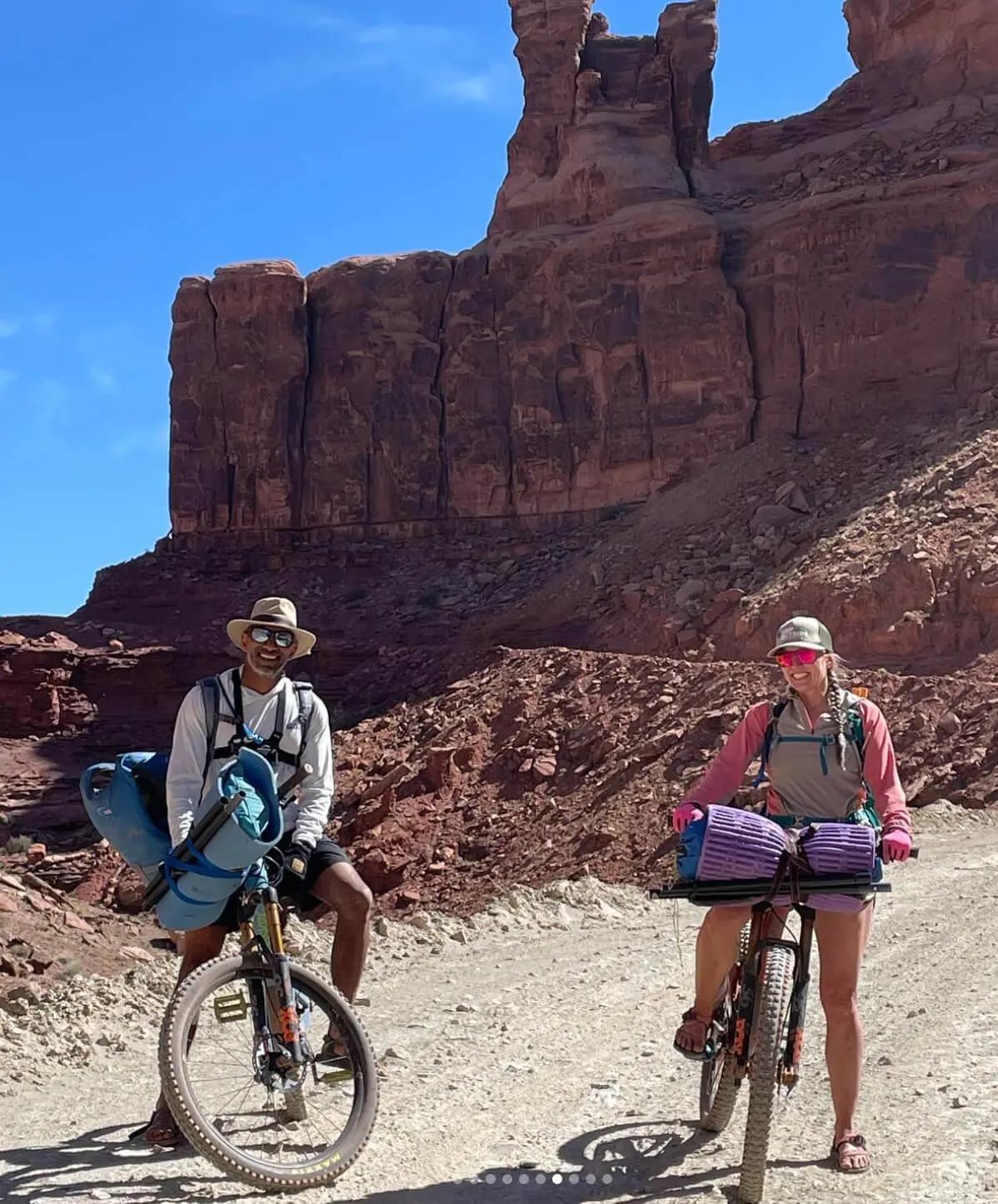Choosing Sustainable Dive Sites: What to Know Before You Go
If you’ve gotten the diving bug and are ready to take it further than your local dive shop, this guide is for you. Maybe you’ve mastered the basics with your local dive shop or explored the usual vacation reefs, and now you’re craving something more meaningful. That’s exactly what led me to start seeking out scuba diving destinations that don’t just deliver epic underwater experiences – but also protect the very places we’re diving in.
I’m Emma Desrochers, an outdoor enthusiast, writer, and diver who’s been exploring wild places since I was 19. I grew up near the coast in Maine, always swimming, always drawn to the ocean—but it was snorkeling off the coast of Ecuador at 19 that made something click. I knew I wanted to dive. Not long after, I found a volunteer program in Thailand with a coral restoration nonprofit. I got my Open Water certification there and spent weeks doing coral species surveys and taking care of underwater nurseries. That experience completely shifted how I saw diving—from a fun sport to a way to directly support ocean health.
Since then, I’ve been diving in Thailand, Hawaii, and Florida. I got my Advanced Open Water in 2024 after moving to Hawaii for 3 years, and I recently picked up an underwater camera setup to capture more of the magic. The more I dive, the more I’m reminded how important it is to protect these fragile ecosystems. That’s why I put together this guide—to help fellow divers find scuba destinations that offer jaw-dropping marine life and a feel-good, eco-conscious approach to exploring the underwater world.
In this Sustainable Diving Destinations guide, I’ll break down some of the best sustainable scuba diving destinations across the U.S., Mexico, and the Caribbean. These are places where conservation matters, where marine parks are thriving, and where your dive dollars support the long-term health of the ocean. I’ll walk you through when to go, what you might see, what level of certification you’ll need, and what makes each destination special—from kelp forests and coral reefs to cenotes and shipwrecks. Without further ado let’s dive right in!
Sustainable Vs. Eco-Friendly Diving – What’s the Difference?
These terms are often used interchangeably but there is a subtle difference to how they are understood. Eco-friendly diving focuses on reducing your individual impact as a diver. This includes following low-impact dive practices such as good buoyancy, not touching or harassing marine life, reef-safe sunscreen, and more. Also your responsibility to choose eco-conscious dive operators and minimize your waste and pollution while traveling. It’s all about your behavior and choices as an individual traveler and/or diver.
Sustainable diving broadens the definition to the long-term health and management of dive destinations and marine ecosystems. This includes supporting conservation or restoration efforts, diving in places with sustainable tourism models (like marine protected areas or limited-access sites), ensuring local communities benefit from dive tourism, and promoting dive education and awareness for future generations. This is more systemic and about how the diving industry or location can continue without degrading the ecosystems we rely on and love.
What Makes a Dive Site or Dive Destination Sustainable?
We selected our featured scuba diving destinations for their commitment to conservation, marine protection, and responsible dive practices. Our criteria included:
Protected Marine Areas / High Ecosystem Health
When dive sites are located in Marine Protected Areas (MPAs) or regions with strong conservation policies, the ecosystems are often healthier, more biodiverse, and better managed. These protections limit overfishing, anchoring, pollution, and harmful development. For divers, that means more abundant marine life and intact coral reefs, but it also means your visit helps support a location that values long-term ocean health.
What to Look For:
- Officially designated marine parks or reserves
- Dive operators that follow MPA regulations
- Fees that directly support reef management and enforcement
Conservation Efforts & Support
These destinations are actively involved in marine conservation—whether through coral restoration, species monitoring, sustainable fishing regulations, or community education. When you dive with operators who support these efforts (financially or hands-on), your trip contributes to those programs. It’s a great way to align your adventures with positive environmental impact. Many of these areas are not in marine protected areas, making their efforts even more important to the overall long-term ocean health.
What to Look For:
- Dive shops involved in coral planting or marine life research
- Eco-certifications (like Green Fins, PADI AWARE partnerships)
- Local NGOs or nonprofits focused on ocean protection
Shore-Diving / Freshwater Diving
Shore diving and freshwater diving reduce the environmental footprint of a dive. You skip the fuel-heavy boat ride, reduce anchor damage risk, and often dive in less trafficked ecosystems. Freshwater scuba diving destinations like cenotes, quarries, or lakes can also relieve pressure from overused reef systems while offering unique geological and biological sights.
What to Look For:
- Easy access dive sites from shore
- Minimal or no boat traffic
- Opportunities for cave, spring, or lake dives with good visibility
Limited Access
Some of the healthiest dive sites are in places that limit how many divers can visit per day – or require permits, guides, or extra effort to reach. While it can feel more logistically challenging, these restrictions help prevent overcrowding, coral damage, and stress to marine life. Fewer fins in the water means more sustainable diving long-term.
What to Look For:
- Permit-only or limited-entry sites
- Remote or boat-only access requiring small group tours
- Operator guidelines that limit diver impact (e.g., no gloves, no touching, no feeding wildlife)
Sustainable Diving Destinations in the US, Mexico & Caribbean
Protected Marine Areas / High Ecosystem Health
Key West, Florida, United States
Key West is the southernmost point of the Florida Keys, and is a top scuba diving destination in the continental U.S. Dive operators here offer boat dives to nearby reefs and wrecks. It is part of the Florida Keys National Marine Sanctuary, which protects coral reefs and shipwrecks through mooring buoys, reef monitoring, and strict regulations.
- Scuba prerequisites: Open Water is enough for reef dives, but wrecks like the Vandenberg require Advanced Open Water or a deep diver specialty.
- When to go: May to September for warmer water and better visibility; winter can bring choppier conditions.
- Marine life to see: Sea turtles, southern stingrays, reef sharks, Goliath grouper, and schools of snapper and grunts.
- Best sites: Vandenberg Wreck (Advanced), Western Sambo Reef (All Levels)
Key Largo, Florida, United States
Key Largo is part of the Northern Florida Keys, and is another top dive destination in Florida. Dive shops here offer mostly boat diving trips to John Pennekamp Coral Reef State Park and the Florida Keys National Marine Sanctuary. This is the first underwater park in the U.S., with decades of active marine protection.
- Scuba prerequisites: Open Water is sufficient for most sites.
- When to go: May to September for the clearest water and calm seas.
- Marine life to see: Parrotfish, nurse sharks, eagle rays, barracuda, and massive brain coral heads.
- Best sites: Molasses Reef (All Levels), Christ of the Abyss (Beginners), Spiegel Grove (Advanced)
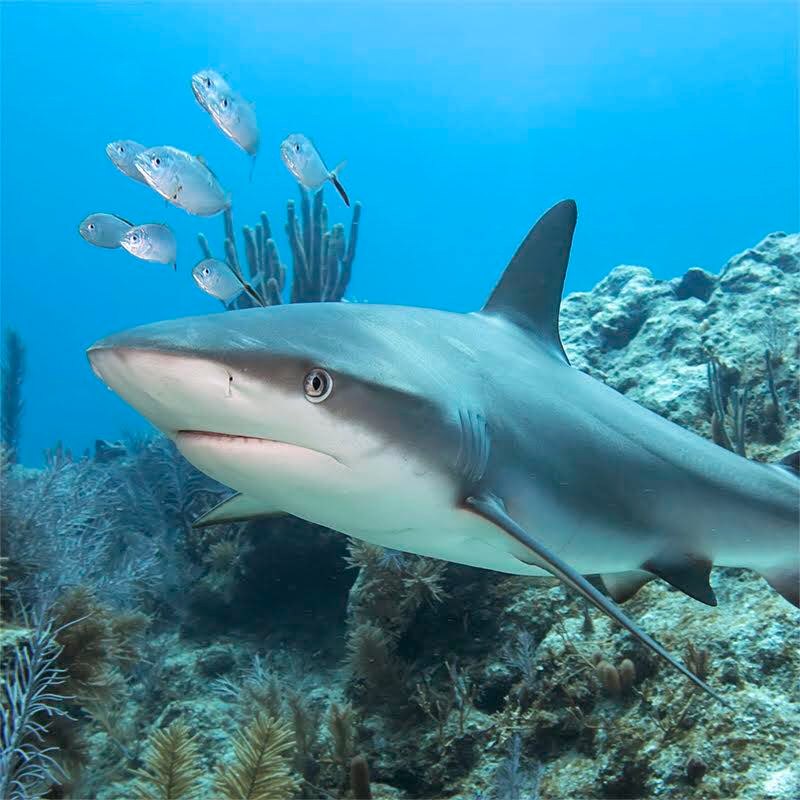
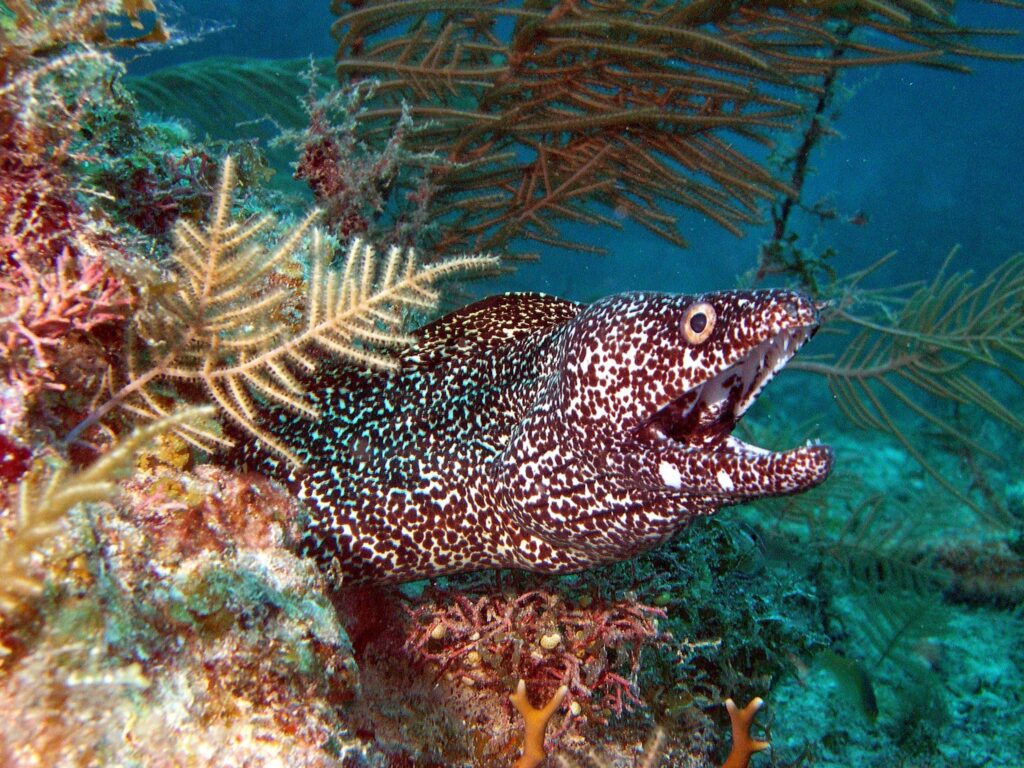
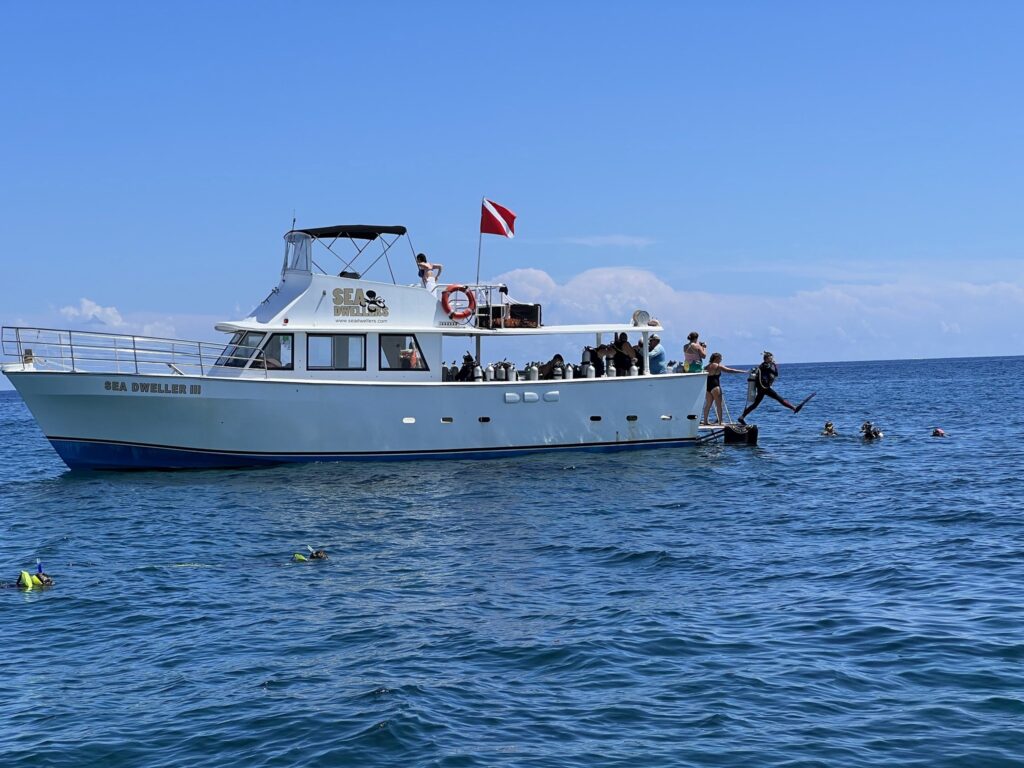
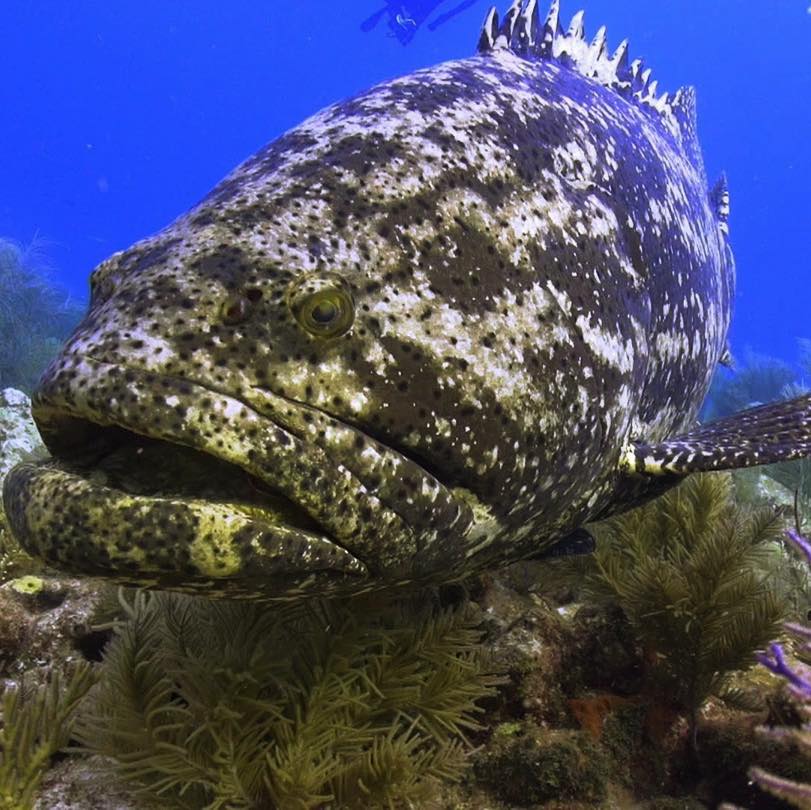
Cabo Pulmo, Baja California Sur, Mexico
A remote village turned marine conservation success story, Cabo Pulmo is located in a protected bay in Baja California Sur, Mexico (about 2 hours from Cabo) and is one of the most successful examples of a marine reserve recovery in the world. It’s a UNESCO World Heritage Site and home to the Cabo Pulmo National Park, where fishing is banned and dive operators work under strict sustainability guidelines. All scuba trips are boat trips, and they offer Discovery trips for those new to diving as well as certified diver trips. Options with transport from Cabo make it super easy to take a day trip from Los Cabos to dive here.
- Scuba prerequisites: Open Water is enough for most sites, but strong swimming skills are recommended due to currents.
- When to go: October to December for warm water and great visibility.
- Marine life to see: Massive schools of bigeye jacks, bull sharks (seasonal), sea lions, (huge) groupers, and healthy coral.
- Best sites: El Vencedor (Open Water), El Bajo (Open Water), Los Morros (Advanced – strong currents), El Islote (Open Water)
Desecheo Island, Puerto Rico, United States
Located about 13 miles off the west coast of Puerto Rico near Rincon, Desecheo Island is a boat-access-only scuba diving destination. It’s part of the Desecheo National Wildlife Refuge, a protected area managed by the U.S. Fish and Wildlife Service, where commercial fishing and landing on the island are prohibited. These protections have helped preserve vibrant coral reefs and a diverse range of marine life.
- Scuba prerequisites: Open Water certification is sufficient for most sites, but some deeper or drift sites may be better for Advanced divers.
- When to go: December to August offers the best conditions; visibility is typically excellent year-round.
- Marine life to see: Sea turtles, nurse sharks, schools of jacks, barracuda, eagle rays, and healthy hard corals and sponges.
- Best sites: Candyland (Intermediate), Aquarium (Beginner), Las Cuevas (Advanced)
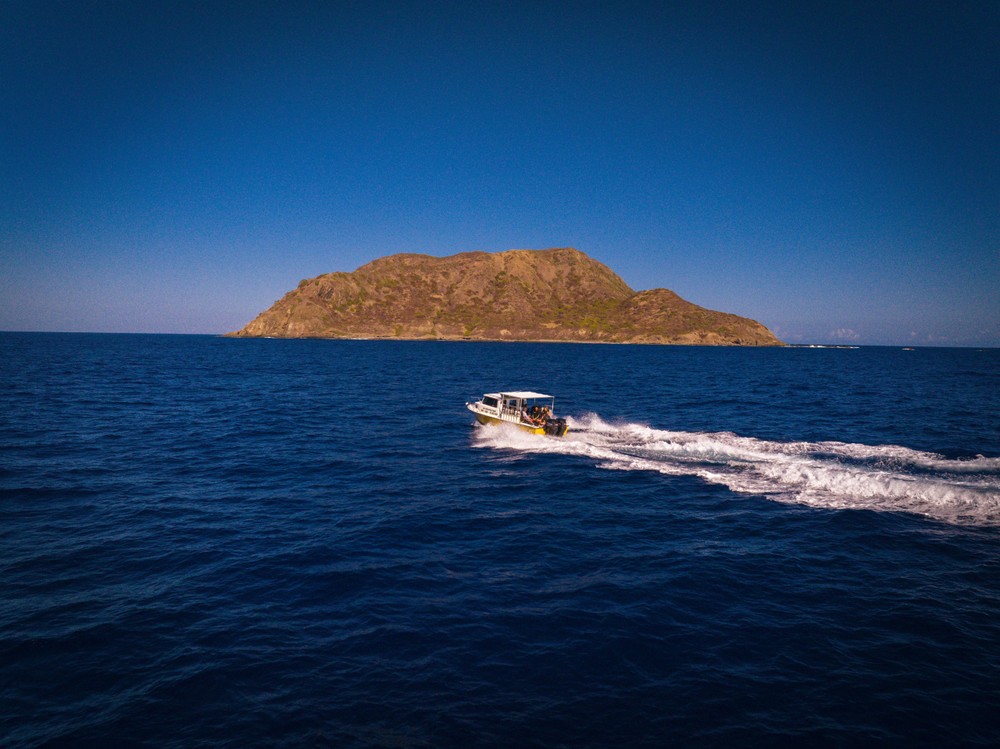
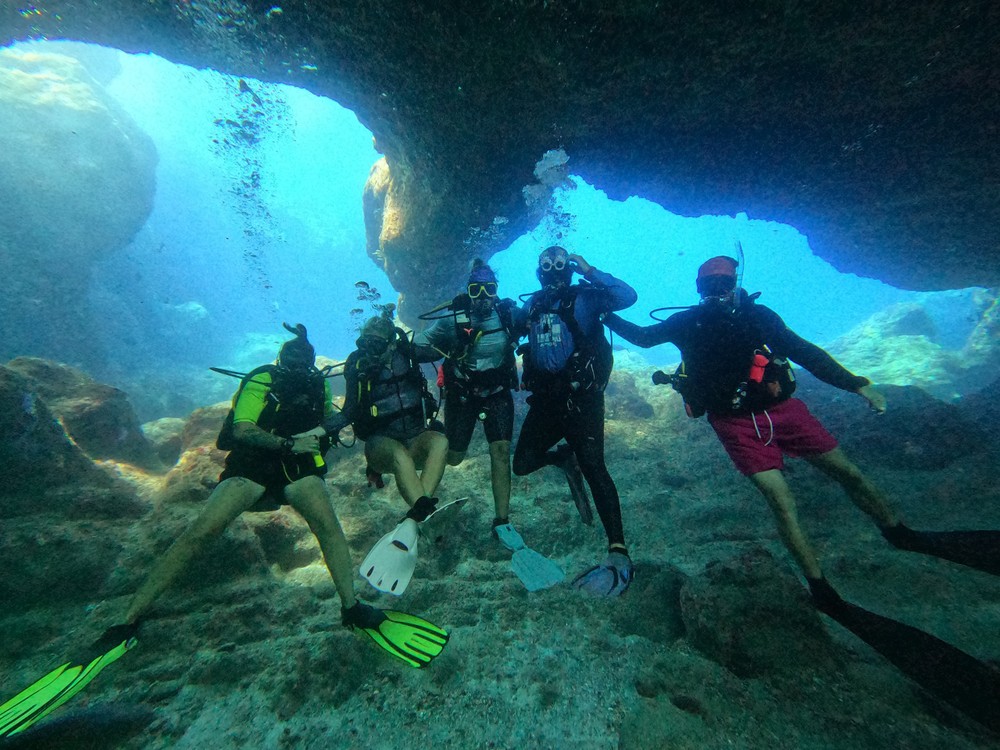
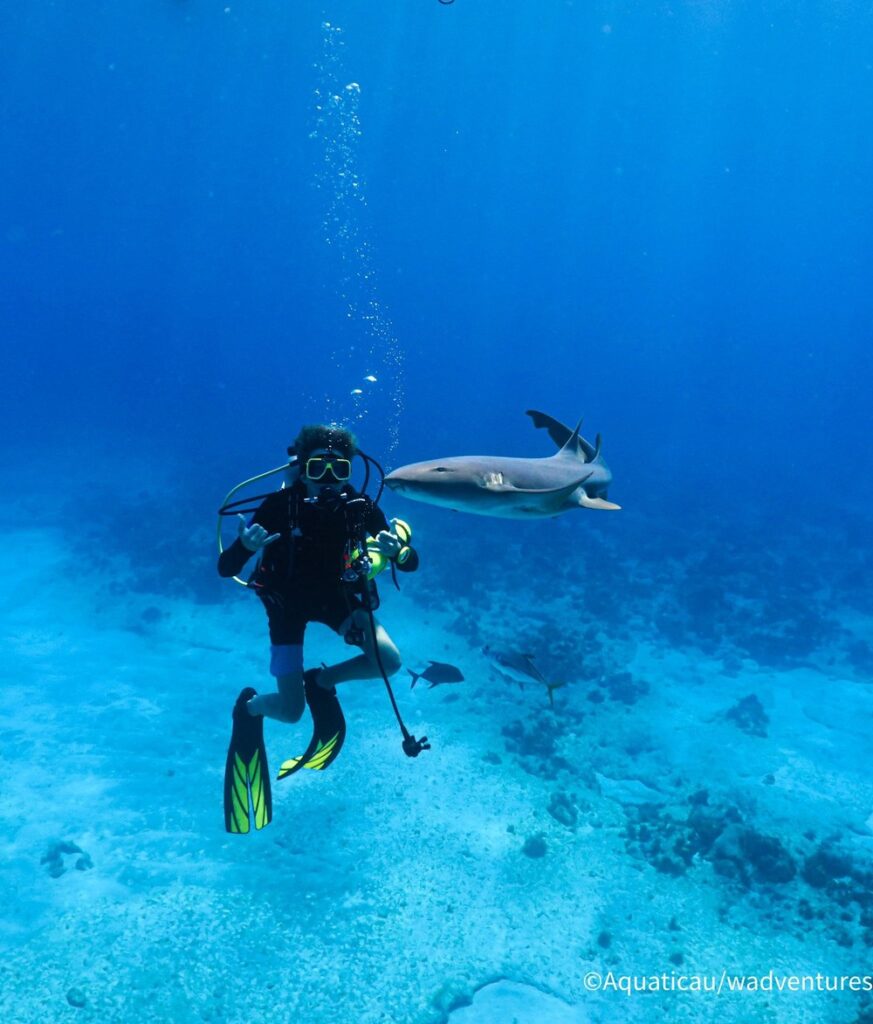

Molokini Crater, Kihei, Maui, United States
Molokini Crater is located off the coast of Maui in a crescent-shaped volcanic islet, requiring a boat dive. Found within the Molokini Shoal Marine Life Conservation District, this partially submerged crater is a top scuba diving destination in a protected marine area where fishing and anchoring are prohibited, allowing reef life to thrive.
- Scuba prerequisites: Open Water certification is typically sufficient, but dives along the crater’s back wall may require Advanced Open Water due to depth and currents.
- When to go: April to October for the calmest seas and best visibility.
- Marine life to see: Over 250 species of fish, including raccoon butterflyfish, yellow tang, moray eels, and occasionally manta rays or whale sharks. Humpback whales can be heard in winter.
- Best sites: Inside Reef (Beginners), Back Wall (Advanced)

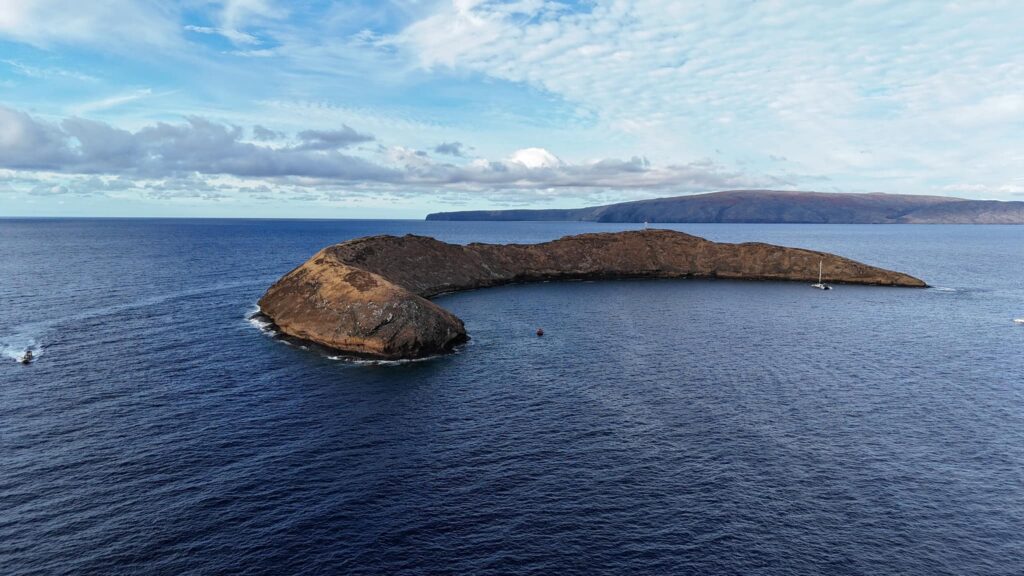
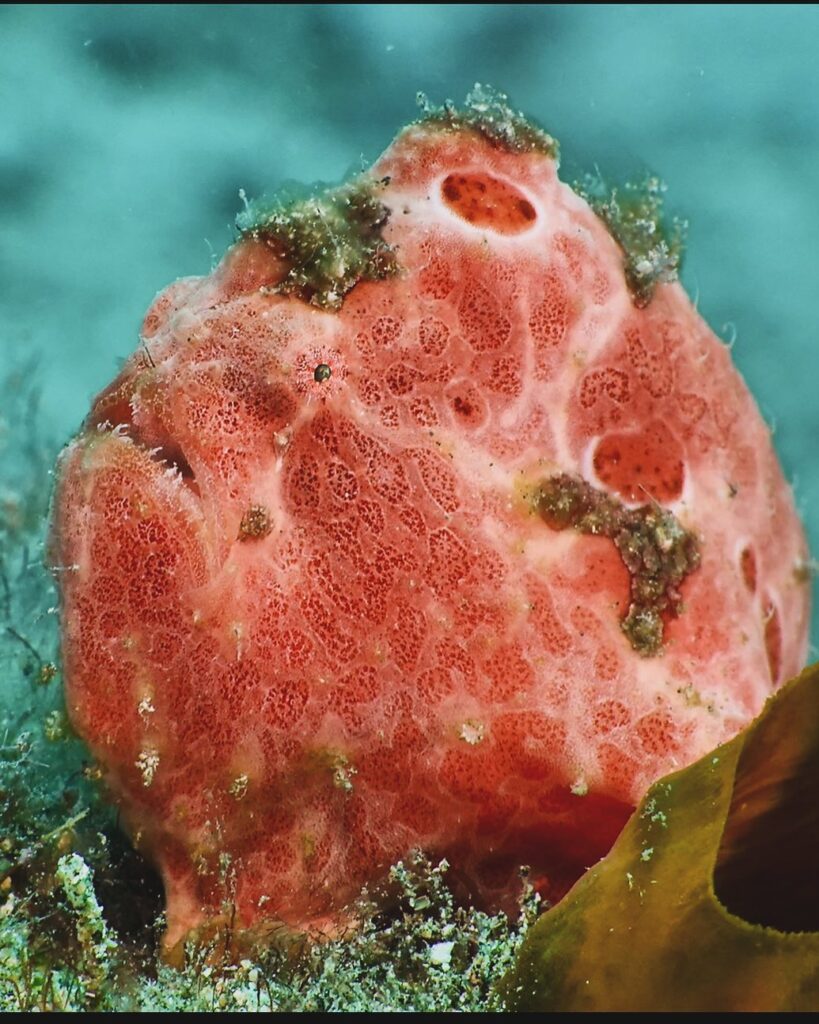
Catalina Island, California, United States
Off the coast of Southern California, Catalina Island is part of California’s Marine Protected Areas (MPAs) and Blue Cavern State Marine Conservation Area, where fishing and harvest are limited. Boat dives and shore dives from Avalon and Two Harbors are available in this renowned scuba diving destination.
- Scuba prerequisites: Open Water certified, though drysuit training is helpful due to cold water.
- When to go: July to October for warmer water and calmer seas.
- Marine life to see: Giant kelp forests, Garibaldi (California state fish), bat rays, horn sharks, and sea lions.
- Best sites: Casino Point Dive Park (Beginners), Blue Cavern Point (Advanced), Italian Gardens (Intermediate)
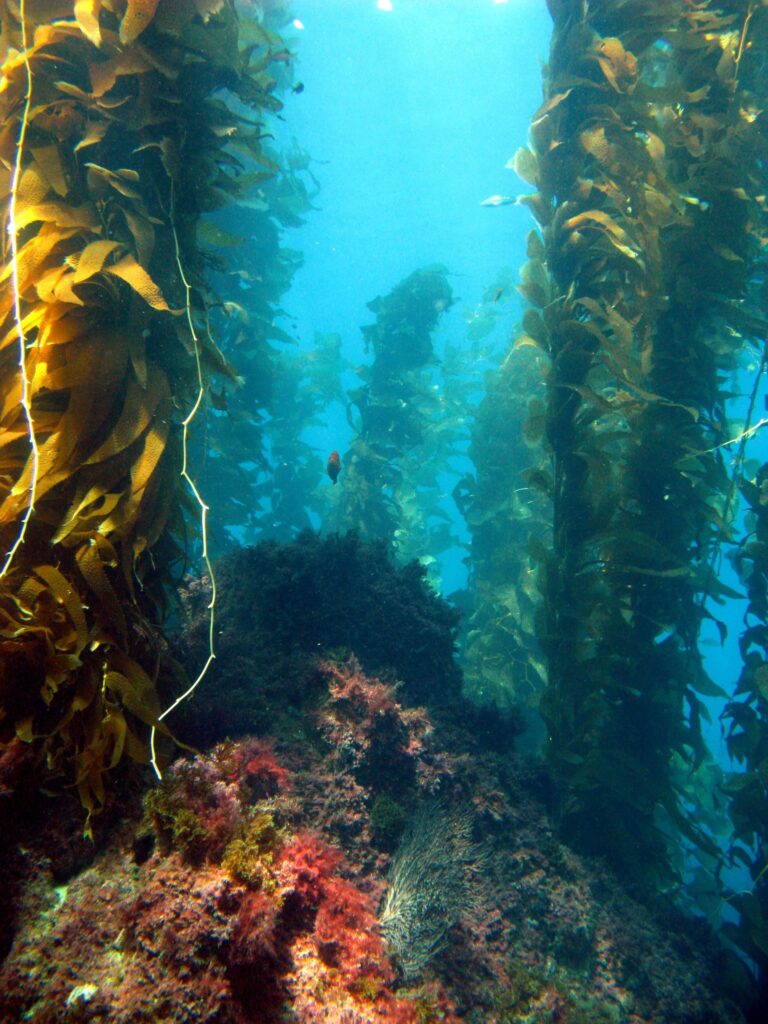
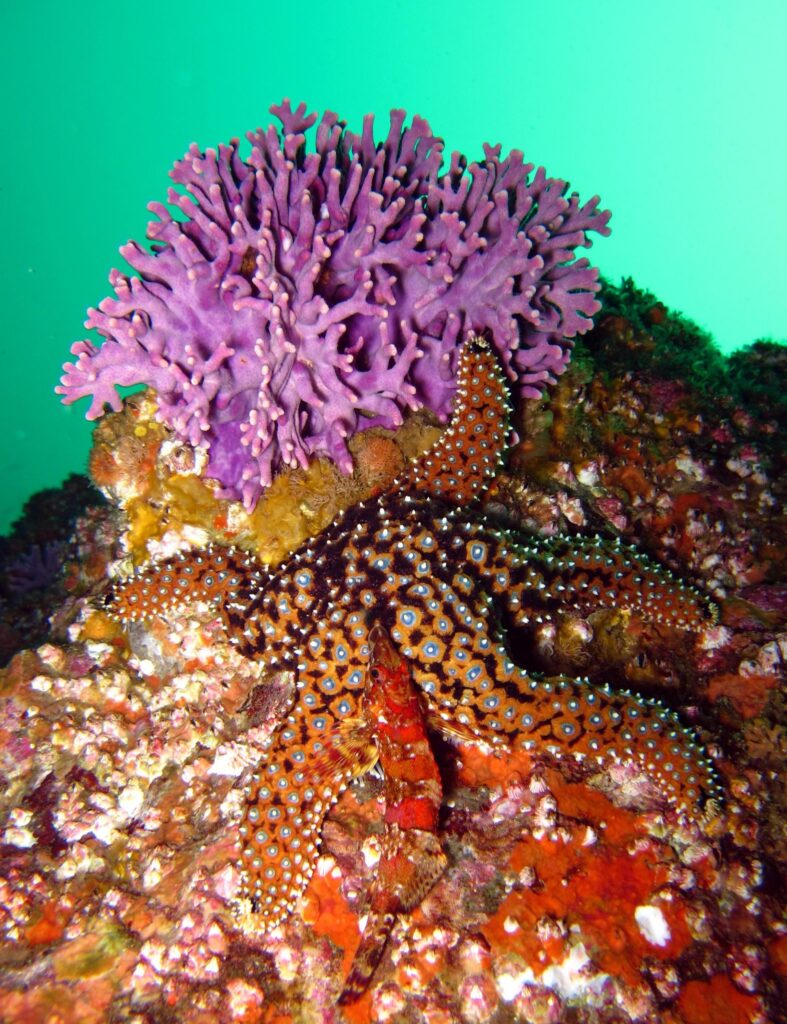

Monterey Bay, California, United States
Monterey Bay is an iconic scuba diving destination situated on the Central California coast, with both shore and boat diving options. It is located within the Monterey Bay National Marine Sanctuary, one of the largest marine sanctuaries in the U.S. Anchoring restrictions and strict conservation rules protect kelp forests and marine mammals.
- Scuba prerequisites: Open Water, but cold water experience and drysuit training is recommended.
- When to go: September to November for best visibility; summer brings more kelp but lower viz.
- Marine life to see: Sea otters, harbor seals, nudibranchs, giant kelp forests, wolf eels, and sometimes mola mola.
- Best sites: Breakwater (Beginners), Lovers Point (Intermediate), Point Lobos State Reserve (Advanced, Permit Required)
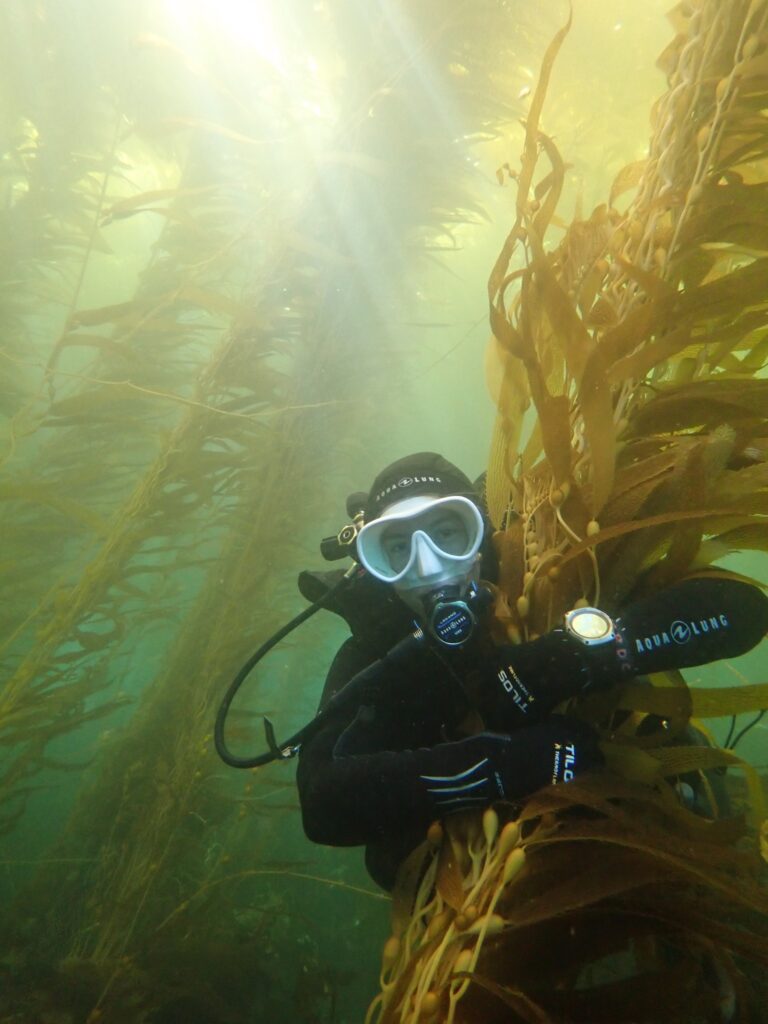
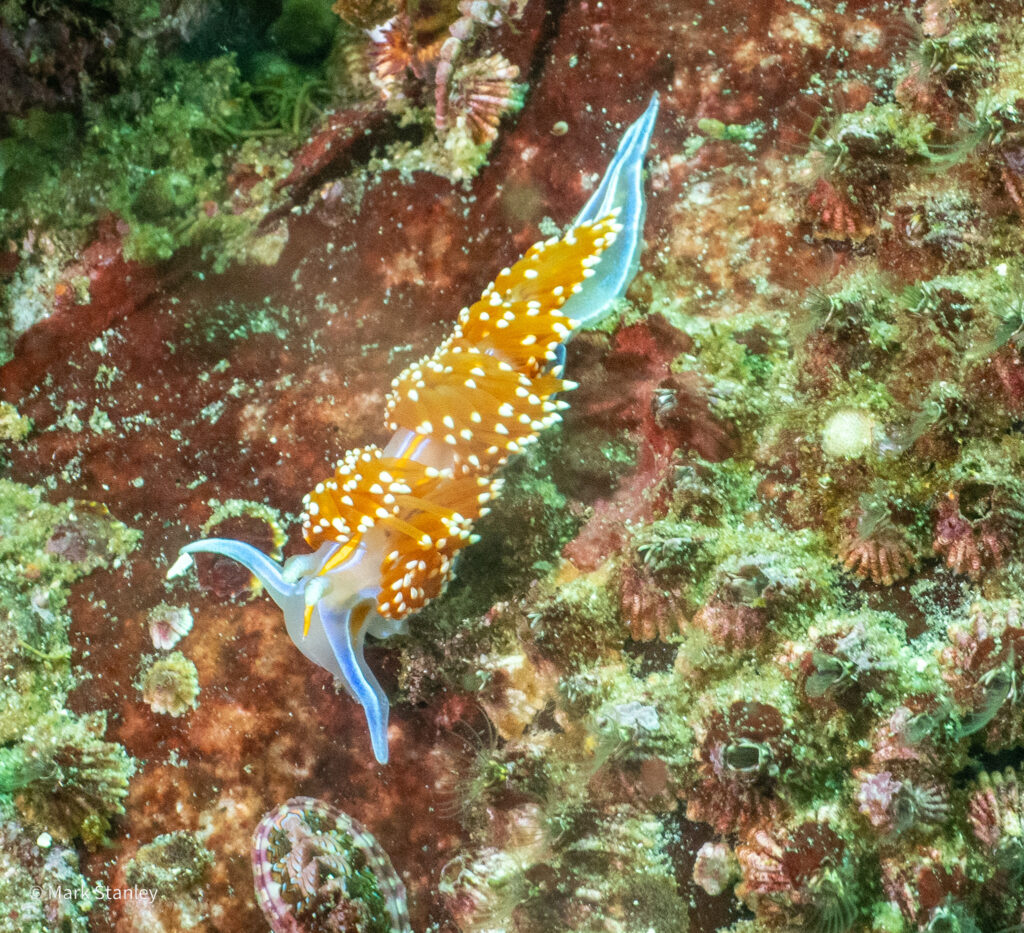
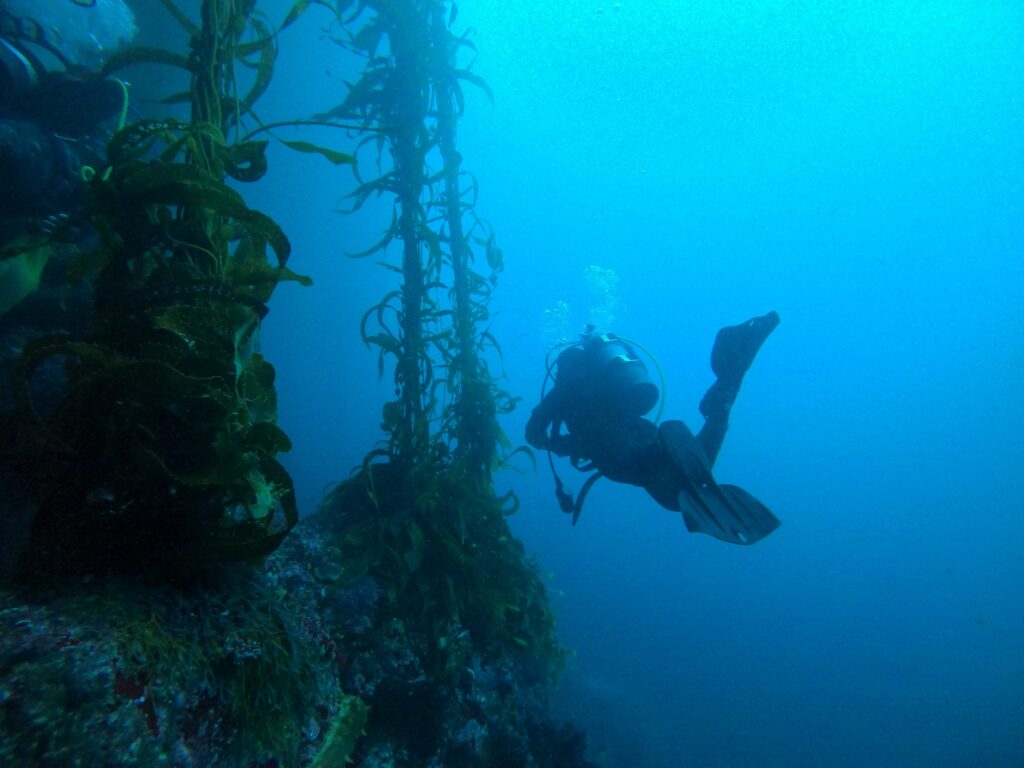
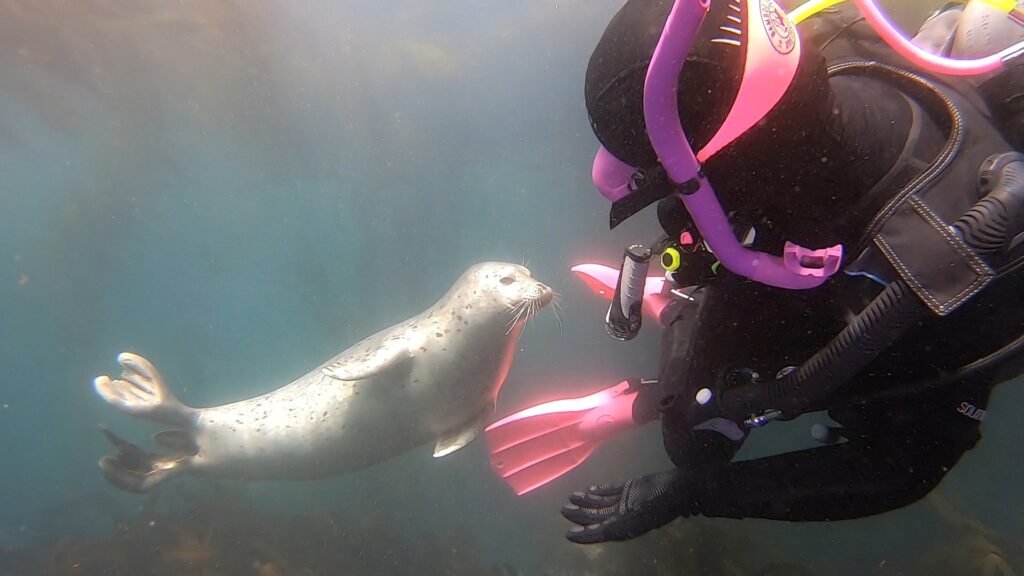
Cozumel, Quintana Roo, Mexico
Cozumel is off the coast of Playa del Carmen in the Caribbean, known for its world-class drift boat diving thanks to the strong currents that sweep along its western reefs. It’s part of the Arrecifes de Cozumel National Park, a protected marine area with strict conservation policies, designated mooring buoys, and enforced dive limits to help preserve the reef’s delicate ecosystem.
- Scuba prerequisites: Open Water is fine, but strong drift diving comfort is a must.
- When to go: March to June for visibility and warm conditions; avoid hurricane season (Sept–Oct).
- Marine life to see: Splendid toadfish (endemic), eagle rays, turtles, reef sharks, and colorful reef fish.
- Best sites: Palancar Reef (All Levels), Santa Rosa Wall (Intermediate), Colombia Deep (Advanced)
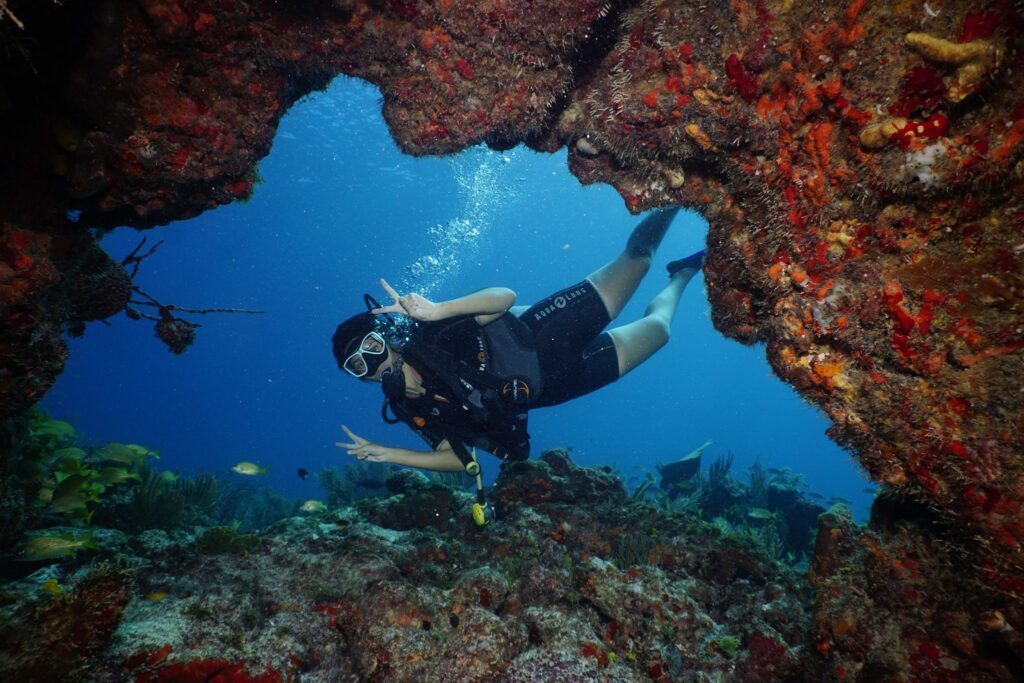
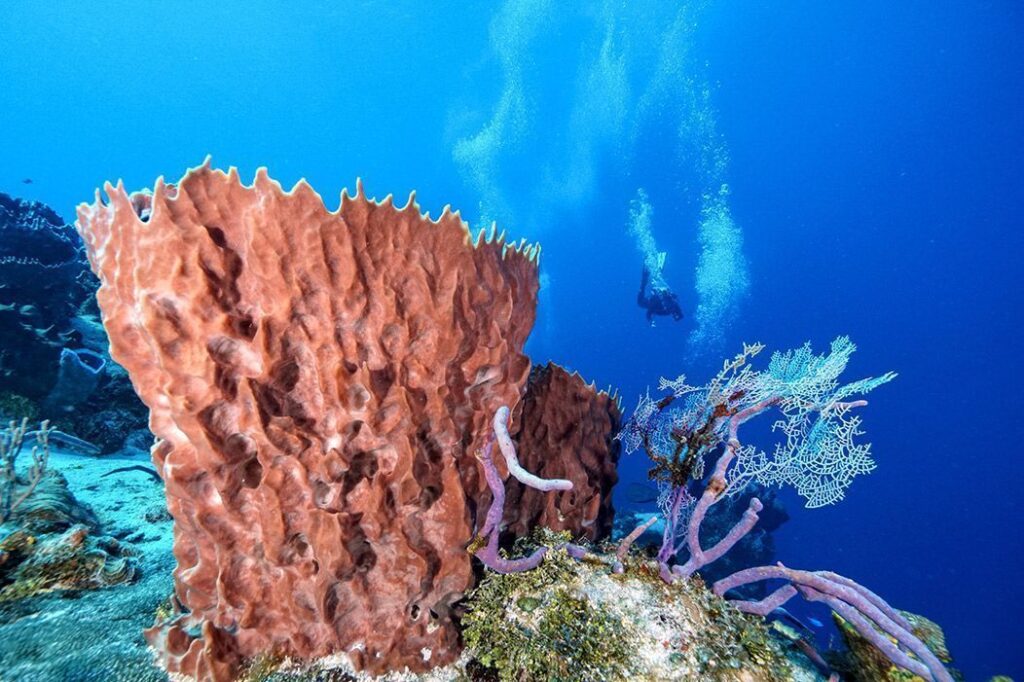
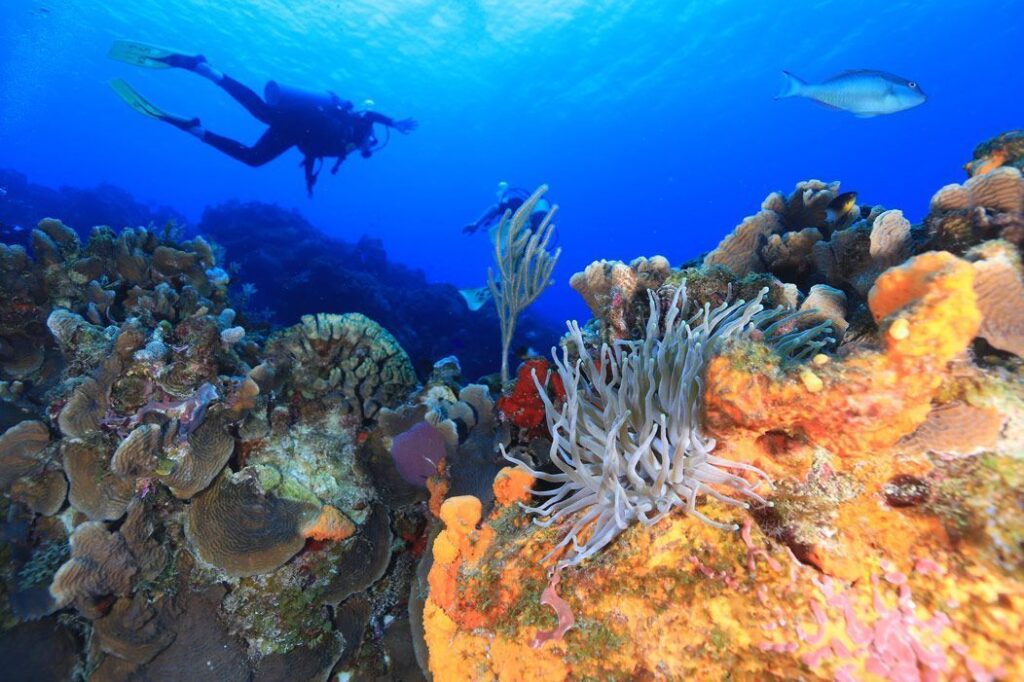
Great Blue Hole, Lighthouse Reef Atoll, Belize
One of the most iconic scuba diving destinations in the world, the Great Blue Hole is a massive marine sinkhole located in Lighthouse Reef Atoll, about 40 miles offshore from Belize City. It lies within the Belize Barrier Reef Reserve System, a UNESCO World Heritage Site. The site’s isolation and status within a protected marine reserve help preserve its pristine condition. The diving here is almost exclusively boat diving because of it’s location (unless you’re a sea turtle).
- Scuba prerequisites: Advanced Open Water certification recommended due to depth (130+ ft) and nitrogen narcosis risk.
- When to go: April to June for the best visibility and calm conditions.
- Marine life to see: Reef and bull sharks, midnight parrotfish, deepwater stalactite formations, and other pelagics.
- Best sites: The Blue Hole itself (Advanced), Half Moon Caye Wall (Intermediate), Long Caye Wall (Beginner–Intermediate)
Bonaire, Caribbean Netherlands
Bonaire is renowned as one of the top shore diving destinations globally, with over 85 marked dive sites around the island. It is the undisputed shore diving capital of the world, with the reef often less than 30 feet from shore. The entire coastline is protected as part of the Bonaire National Marine Park, established in 1979, which includes strict conservation regulations and mooring systems to prevent anchor damage.
- Scuba prerequisites: Open Water certification is ideal; many dive sites are accessible directly from shore.
- When to go: Year-round diving with excellent visibility; September to November tends to be the calmest.
- Marine life to see: Seahorses, frogfish, parrotfish, tarpon, reef squid, and vibrant coral gardens.
- Best sites: 1000 Steps (Intermediate), Salt Pier (Beginner–Intermediate), Hilma Hooker (Advanced)
Conservation Efforts & Support
Kailua-Kona, Big Island, Hawaii, United States
Located on the Big Island’s leeward coast, Kailua-Kona offers both boat and shore diving with access to lava tubes, steep drop-offs, and pelagic deep waters. Several local dive shops in Kona are actively involved in marine conservation, including reef cleanups, education programs, and supporting manta ray identification and protection efforts. Manta rays, in particular, are respected and protected here, with strict guidelines in place for night manta dives.
- Scuba prerequisites: Open Water certification for most sites; Advanced Open Water recommended for blackwater dives or deep offshore sites.
- When to go: April to October for calm seas; manta night dives are good year-round.
- Marine life to see: Reef sharks, green sea turtles, manta rays (especially on night dives), frogfish, and rare pelagic species on blackwater dives.
- Best sites: Garden Eel Cove (Manta Night Dive – Open Water), Eel Cove Wall (Advanced – night/pelagic), Suck ‘Em Up Lava Tube (Open Water)
Culebra, Puerto Rico, United States
A small island off the east coast of Puerto Rico, Culebra is home to Blue Flag–certified beaches and dive shops awarded the PADI Green Star Award for eco-friendly practices. The surrounding waters are part of the Luis Peña Channel Natural Reserve, a no-take zone that protects coral, seagrass beds, and marine life. Dive operators actively promote reef-safe diving and community education.
- Scuba prerequisites: Open Water for most reef sites; Advanced recommended for drift or deeper wall dives. Discover scuba trips also offered.
- When to go: March to August for the calmest seas and warmest water.
- Marine life to see: Spotted eagle rays, hawksbill turtles, Caribbean reef fish, and nurse sharks.
- Best sites: Carlos Rosario Reef (Open Water), Cayo Raton (Open Water), Las Hermanas (Advanced – wall)
Fort Lauderdale, Florida, United States
Fort Lauderdale offers a mix of easy-access shore diving and boat dives to reefs and wrecks along Florida’s southeast coast. The area is home to over 75 artificial reefs, including sunken ships, concrete modules, and other structures that provide habitat for marine life and reduce pressure on natural reefs. Many dive shops here actively support marine conservation through coral restoration partnerships with groups like the Coral Restoration Foundation and SECORE International, and they encourage citizen science and reef monitoring.
- Scuba prerequisites: Open Water for reefs and many wrecks; Advanced Open Water recommended for deeper or drift dives.
- When to go: May to September for the best visibility and calm water.
- Marine life to see: Goliath grouper, southern stingrays, nurse sharks, loggerhead turtles, and vibrant reef fish.
- Best sites: Lauderdale-By-The-Sea (shore dive – Open Water), Tracy & Merci Jesus Wrecks (Advanced), Hog Heaven Artificial Reef (Open Water), Jay Scutti Wreck (Open Water)
Cancún, Quintana Roo, México
While known for its tourist-heavy beaches, Cancún is also home to dive shops supporting conservation efforts and access to MUSA (Museo Subacuático de Arte), an underwater museum that combines art with reef regeneration. Some operators also collaborate with coral nurseries and sea turtle monitoring projects in nearby Isla Mujeres and Cozumel.
- Scuba prerequisites: Open Water for reef and MUSA dives; Advanced Open Water recommended for deeper dives and cenotes inland.
- When to go: November to May for better visibility and calmer seas.
- Marine life to see: Hawksbill turtles, parrotfish, eagle rays, and Caribbean reef sharks.
- Best sites: MUSA (Open Water), Manchones Reef (Open Water), C-58 Wreck (Advanced)
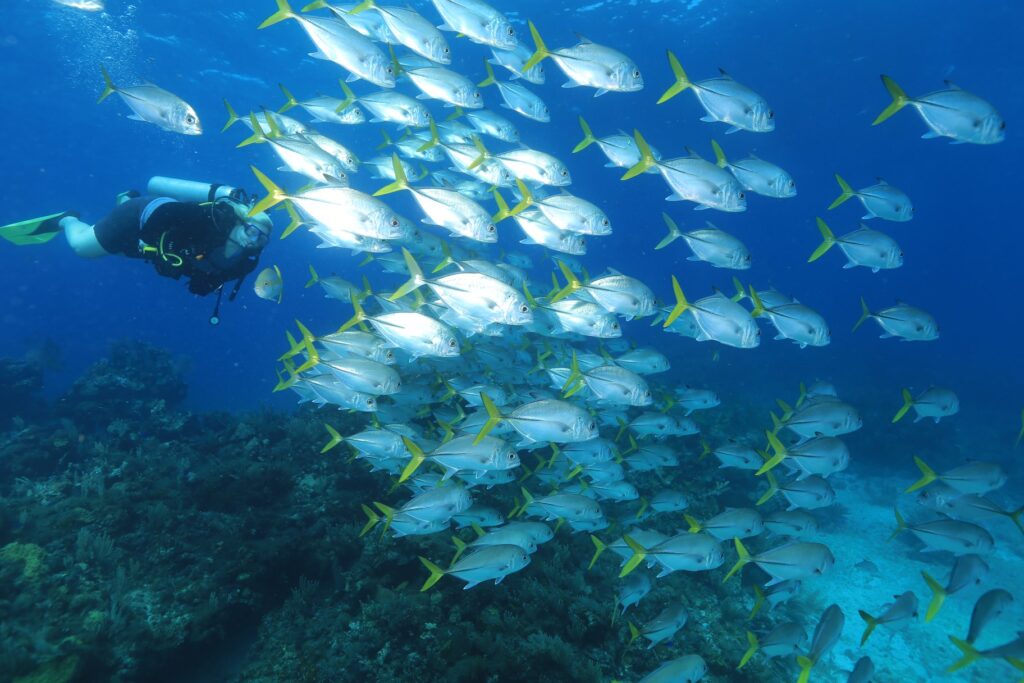
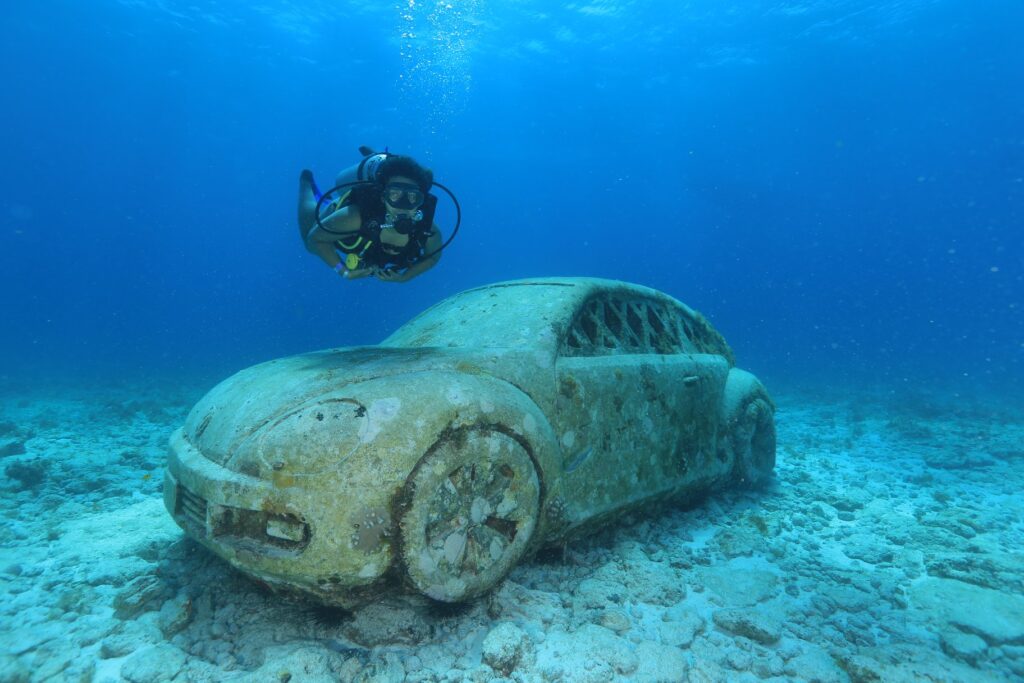
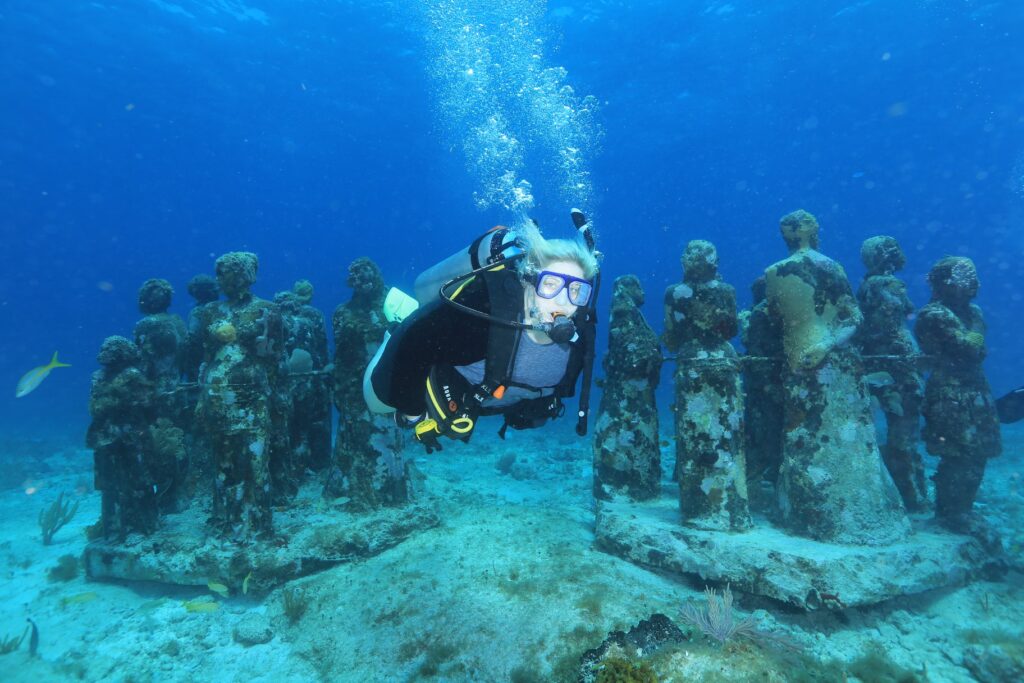
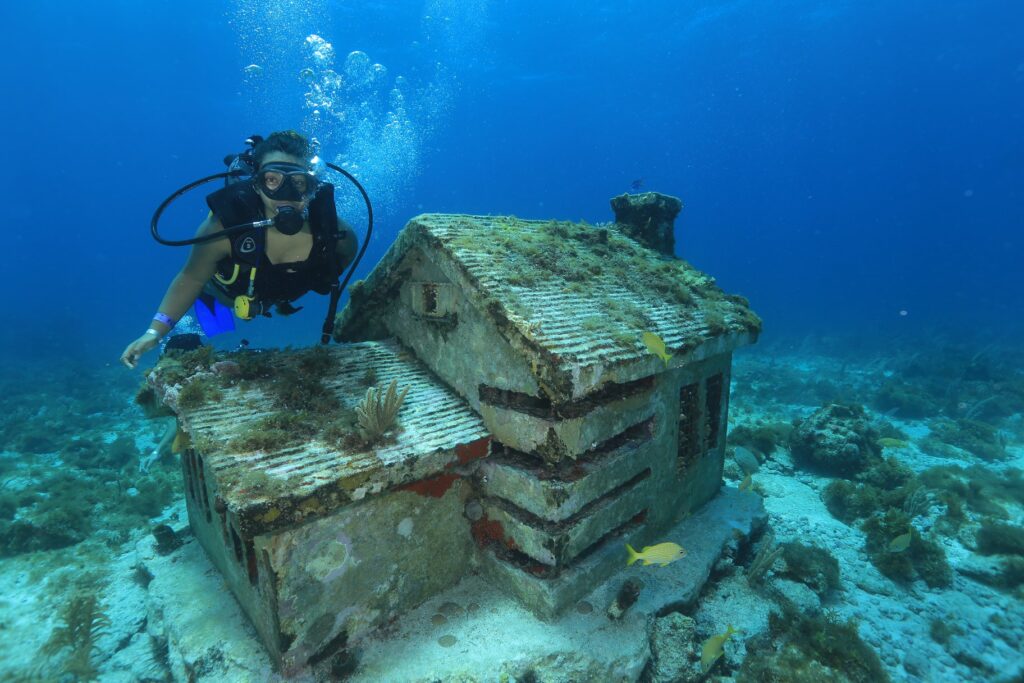
Turks and Caicos Islands
This archipelago in the Atlantic Ocean southeast of the Bahamas is known for its dramatic walls, clear waters, and healthy coral reefs – most of which are accessed by boat. Much of the diving is located within protected zones like the Princess Alexandra Land and Sea National Park and West Caicos Marine National Park, which help ensure minimal fishing and coral degradation.
- Scuba prerequisites: Open Water certification is sufficient, though Advanced Open Water is ideal for deeper wall dives.
- When to go: January to April for whale sightings, but diving is excellent year-round.
- Marine life to see: Humpback whales (in season), reef sharks, Caribbean reef fish, sea turtles, eagle rays.
- Best sites: The Wall (Advanced), French Cay (Intermediate), Grace Bay (Beginner)
Shore-Diving / Freshwater Diving
Koloa Landing, Kauai, Hawaii, United States
Koloa Landing is a popular and easily accessible shore dive on Kauai’s south shore. It’s part of the Lawai Beach marine conservation area, and local dive shops promote responsible dive practices. This scuba diving destination is ideal for beginner divers or those looking to skip a boat ride and still see plenty of reef life.
- Scuba prerequisites: Open Water.
- When to go: May to September for calmest surf.
- Marine life to see: Green sea turtles, dragon moray eels, leaf scorpionfish, endemic Hawaiian reef fish.
- Best sites: Koloa Landing Reef (Open Water)
Maui Shore Dives, Maui, Hawaii, United States
Maui’s western coast offers numerous walk-in dive sites like Makena Landing and Ulua Beach. Many are within the Mokuleia Bay Marine Life Conservation District or other no-take zones, offering healthy reef systems and protected species. Shore diving here allows for low-impact exploration without boat fuel or anchor damage.
- Scuba prerequisites: Open Water.
- When to go: May to October for calmer surf.
- Marine life to see: Hawaiian green sea turtles, frogfish, octopus, manta rays, and reef sharks.
- Best sites: Ulua Beach (Open Water), Makena Landing (Open Water), Five Caves / Five Graves (Advanced; surge and cave entry), Kaanapali (Beginner), (Airport Beach Park–Beginner), Lahaina (Beginner), Kahana (Beginner), Kapalua (Beginner), Napili (Beginner)
San Juan, Puerto Rico, United States
Just steps from the shore in Escambrón Marine Park, the capital of Puerto Rico offers surprisingly rich shore diving right in the capital city. The reef is part of a small protected zone, and some local shops hold PADI Green Star Awards and engage in marine education programs for youth. No boat needed, making it an easy low-impact scuba diving destination. Discovery scuba trips are offered, as well as dive trips for certified divers.
- Scuba prerequisites: Open Water. Discovery trips also offered.
- When to go: May to October for best visibility and calm seas.
- Marine life to see: Seahorses, octopus, reef squid, flounder, and turtles.
- Best sites: Escambrón Beach Reef (Open Water)
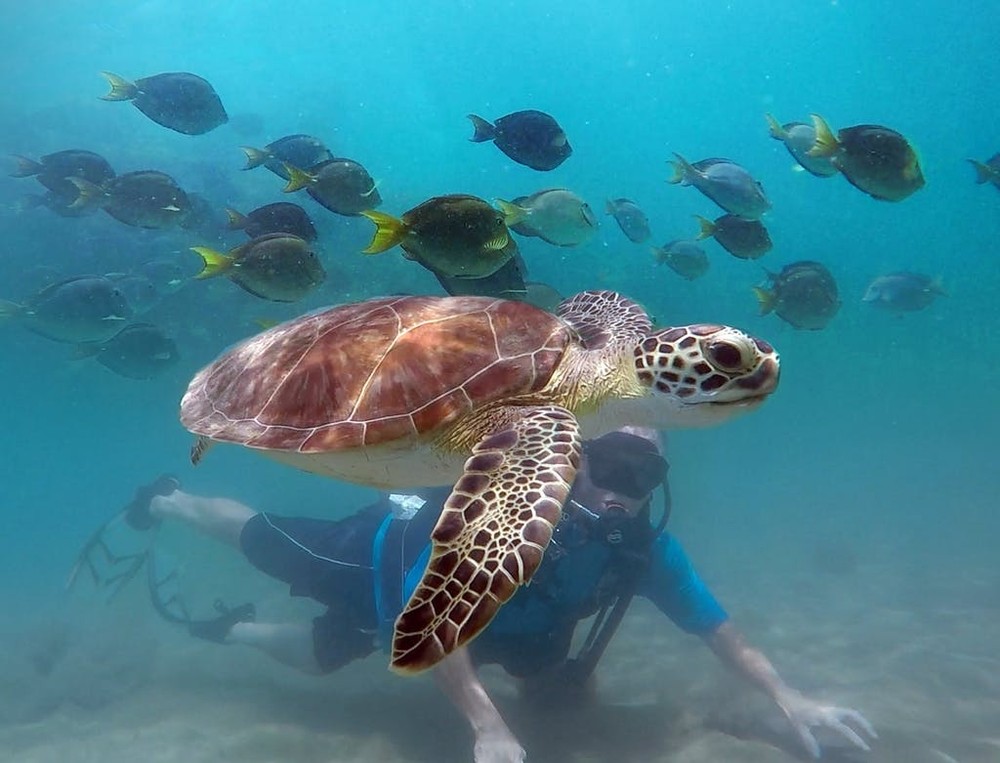
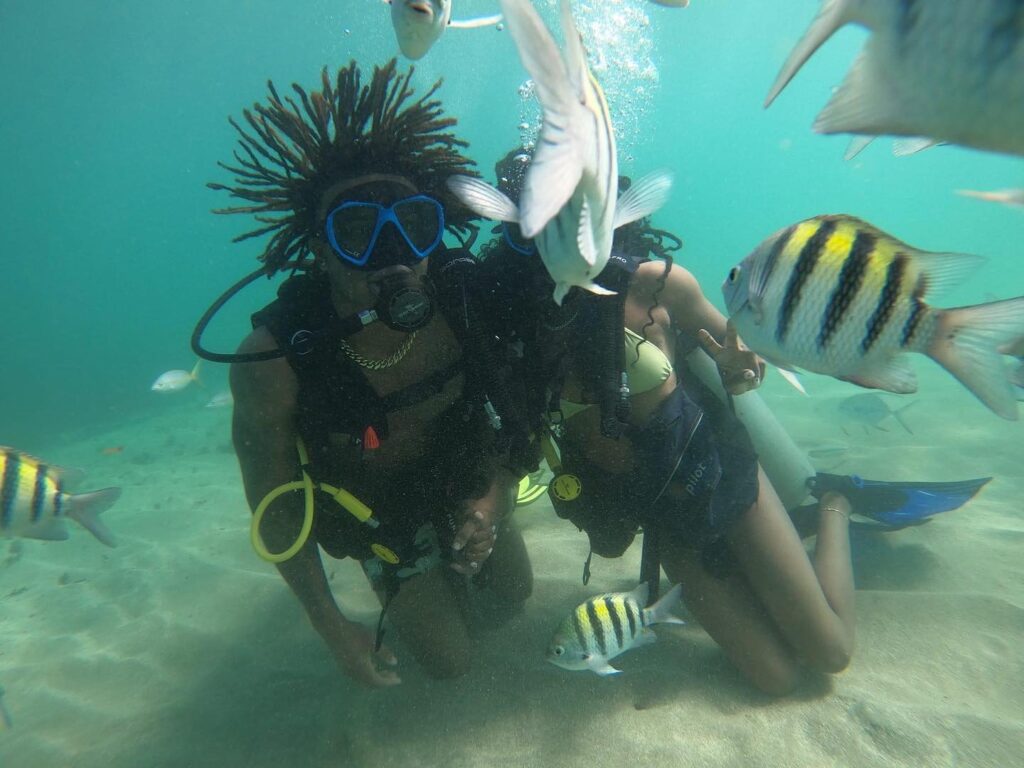
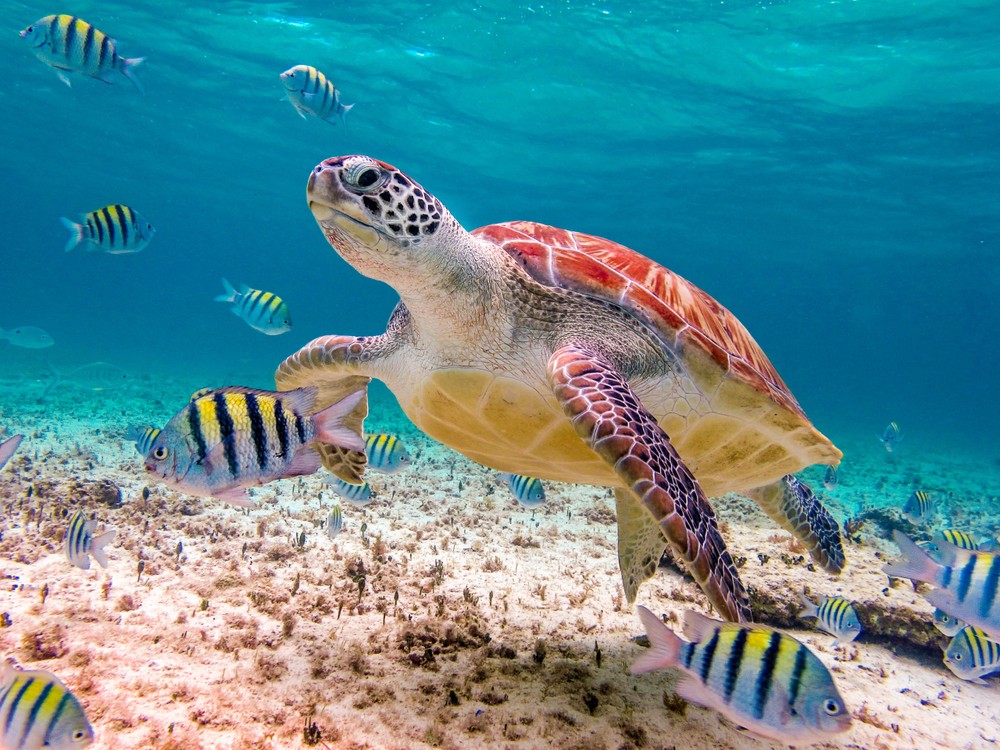
Rincón, Puerto Rico, United States
On Puerto Rico’s west coast, Rincón offers laid-back diving with a mix of boat and shore options. Sites like Steps Beach are part of the Reserva Marina Tres Palmas, a marine reserve that prohibits fishing to allow coral recovery and support endangered species. Dive shops in the area often run reef cleanups and coral education programs. Dive shops in the area offer open water and advanced open water courses.
- Scuba prerequisites: Open Water.
- When to go: Summer and fall (May–October) for calmer surf.
- Marine life to see: Hawksbill turtles, elkhorn coral, parrotfish, spotted eagle rays.
- Best sites: Steps Beach (Open Water), Dogman’s Reef (Open Water), The Wall (Advanced; stronger currents)
Blue Heron Bridge, Riviera Beach, Florida, United States
One of the most famous shore dives in the U.S., Blue Heron Bridge is located in a protected area of the Lake Worth Lagoon. The shallow, calm water and unique man-made structures have turned it into a thriving artificial reef and macro life hotspot. This site offers easy beach access, shallow depths, and an incredible array of marine life, making it a favorite among divers and snorkelers alike. It’s sustainable thanks to its no-take policy and popularity as a training site, reducing pressure on nearby offshore reefs.
- Scuba prerequisites: Open Water; ideal for photographers.
- When to go: Year-round, but best visibility during incoming tide.
- Marine life to see: Seahorses, octopus, batfish, frogfish, flying gurnards, and pipefish.
Best sites: East and West spans under the bridge (Open Water)
Bonne Terre Mine, Bonne Terre, Missouri, United States
Located inland in Missouri, Bonne Terre Mine is one of the largest man-made freshwater dive resorts in the world. This former lead mine is now a submerged labyrinth of tunnels, staircases, and mining equipment preserved in crystal-clear, 60°F water. The site offers walk-in diving, as divers descend 65 stairs into the submerged mine. Diving here helps reduce pressure on marine ecosystems and offers a unique year-round alternative to ocean diving.
- Scuba prerequisites: Open Water; must be comfortable with overhead environments (no cavern cert required, but no surfacing directly above).
- When to go: Year-round (constant water temp and conditions).
- Marine life to see: No marine life—this site is about history and structure.
- Best sites: Guided trail dives throughout the mine’s submerged sections (Open Water +; experience with limited visibility recommended).
Devil’s Den, Williston, Florida, United States
A prehistoric spring within a dry cave, Devil’s Den is a freshwater dive site with shore access to crystal-clear water and ancient fossils embedded in limestone walls. It’s a privately managed site focused on eco-preservation, and access is controlled to prevent overcrowding and degradation.
- Scuba prerequisites: Open Water.
- When to go: Year-round; water is always ~72°F.
- Marine life to see: Few fish, mostly freshwater catfish and small crustaceans.
- Best sites: Main cavern area (Open Water)
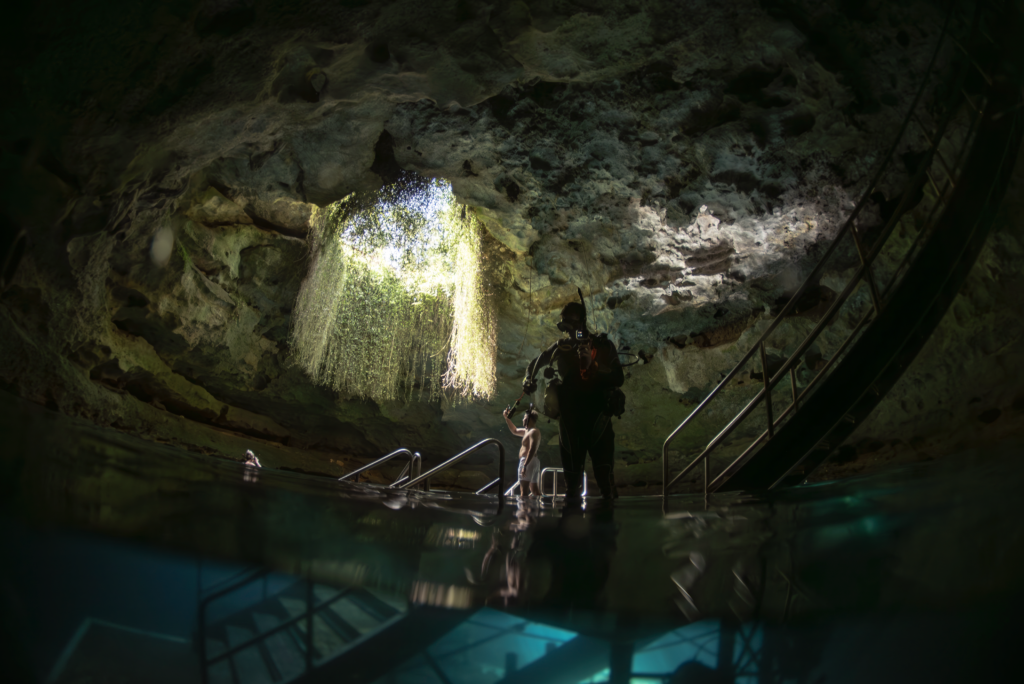
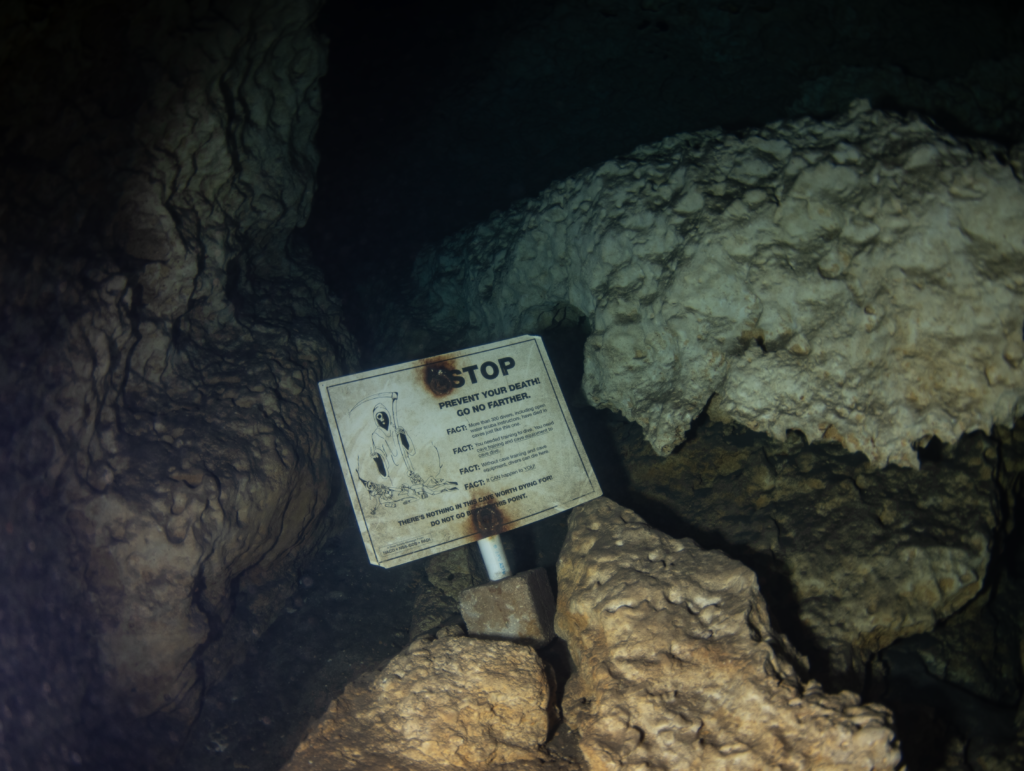
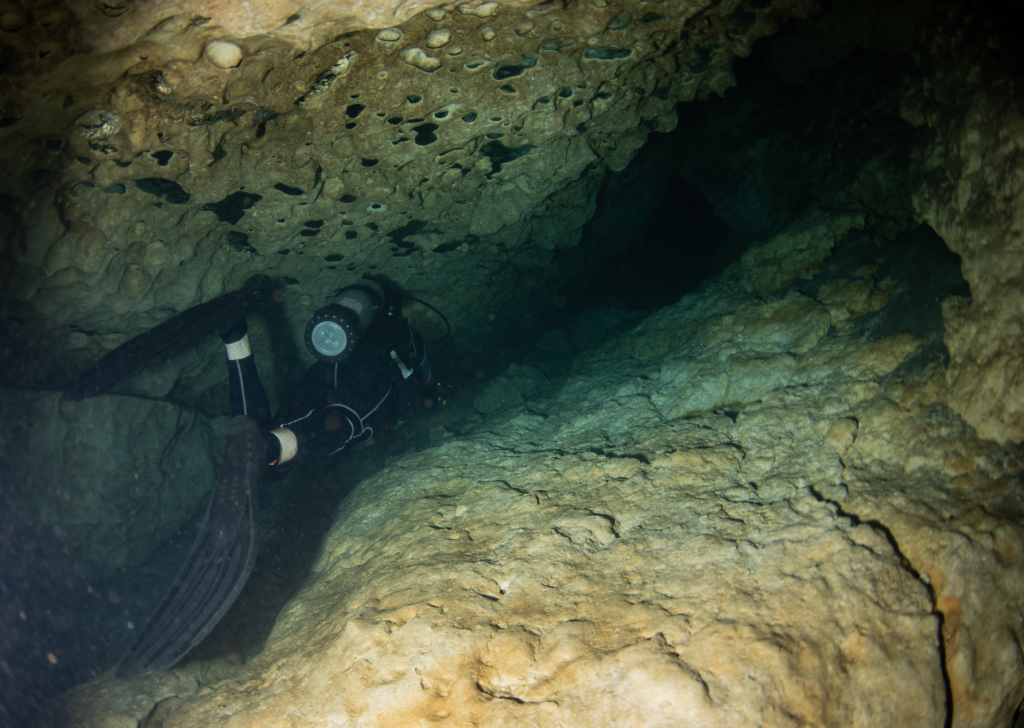
Cenote Angelita, Tulum, Quintana Roo, Mexico
This cenote is a deep, freshwater sinkhole near Tulum famous for its surreal hydrogen sulfide cloud and underwater “island” of trees. As a groundwater-fed system, it’s part of the Riviera Maya Aquifer, and diving with responsible operators (no boat needed!) helps protect the fragile ecosystem by supporting sustainable tourism and limiting development.
- Scuba prerequisites: Advanced Open Water due to depth (~100+ feet).
- When to go: November to April for dry conditions and clearer water.
- Marine life to see: Minimal—look for freshwater fish and tiny crustaceans; the draw is the haunting atmosphere and geological formations.
- Best sites: Cenote Angelita (Advanced)
Limited Access
Lanai Cathedrals, Lanai, Hawaii, United States
Accessible only by boat from Maui or Lanai, this remote island offers is one of Hawaii’s most unique scuba diving destinations. The Cathedrals are massive underwater lava tubes filled with arches and light beams. Lanai is lightly populated, and its dive sites benefit from low traffic and protection under Hawaii’s overall marine conservation efforts, with no anchoring allowed on coral and heavy promotion of reef-safe practices by local operators.
- Scuba prerequisites: Open Water is sufficient for most dives; some swim-throughs may require comfort in overhead environments.
- When to go: May to October for calm seas and the best visibility.
- Marine life to see: Hawaiian monk seals, nudibranchs, pyramid butterflyfish, Hawaiian turkeyfish, and endemic reef fish.
- Best sites: First Cathedral (Open Water), Second Cathedral (Open Water, but requires confidence in swim-throughs)
Niʻihau, Niʻihau Island, Hawaii, United States
Known as the “Forbidden Island,” Niʻihau is privately owned and has no public infrastructure. Dive trips to Niʻihau leave from Kauai and take 2–3 hours each way in the open ocean. Niʻihau’s isolation means its reefs are extremely healthy, with frequent pelagic sightings. Diving here supports low-impact eco-tourism and helps justify protection of one of Hawaii’s least visited marine ecosystems.
- Scuba prerequisites: Advanced Open Water and recent diving experience due to long boat ride, depth, and surge.
- When to go: Late May to early September when ocean conditions allow crossings.
- Marine life to see: Hawaiian monk seals, gray reef sharks, pyramid butterflyfish, longnose hawkfish, and large schools of ulua.
- Best sites: Vertical Awareness (Advanced), Lehua Crater Arch (Advanced)
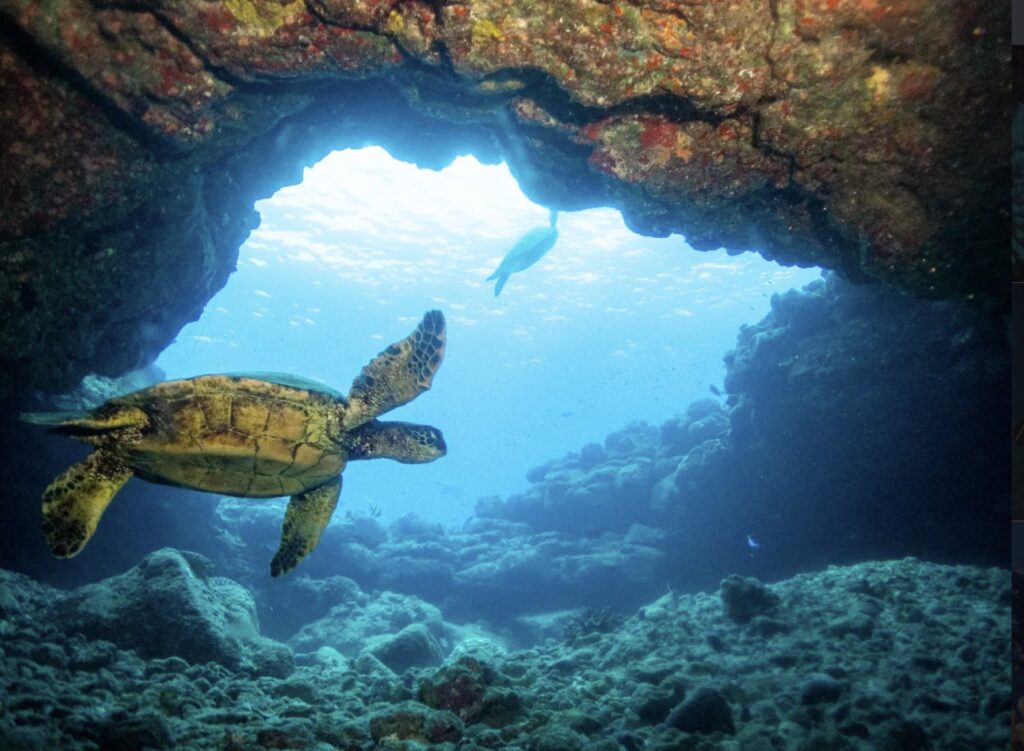
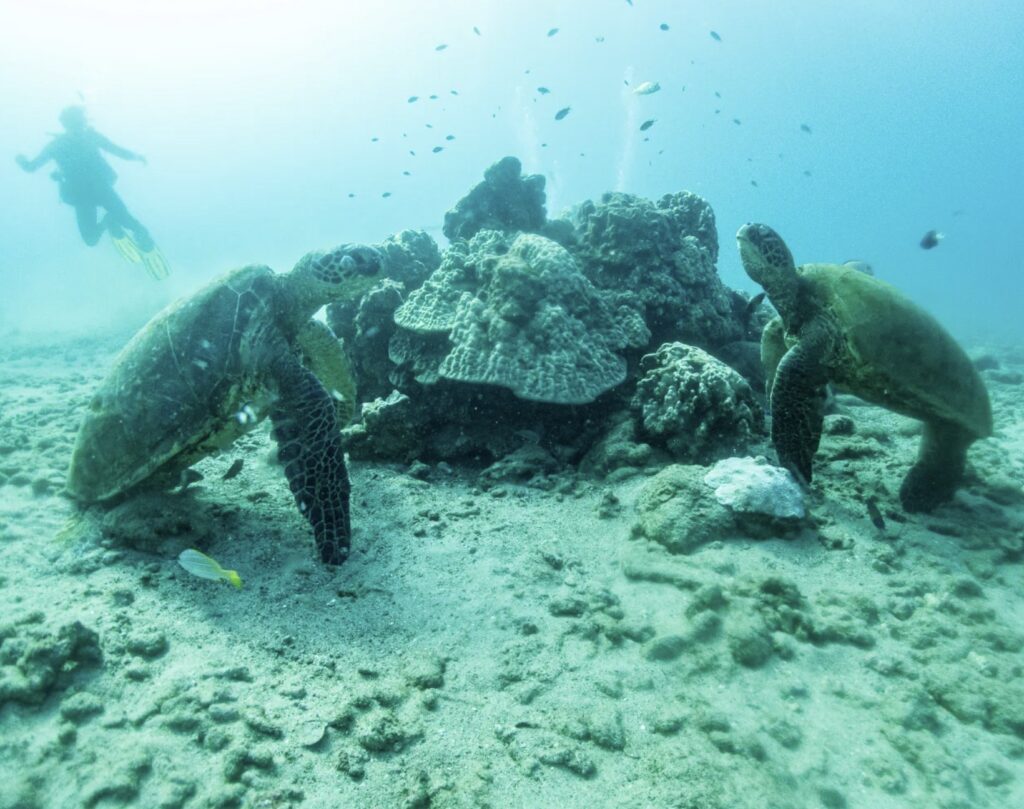
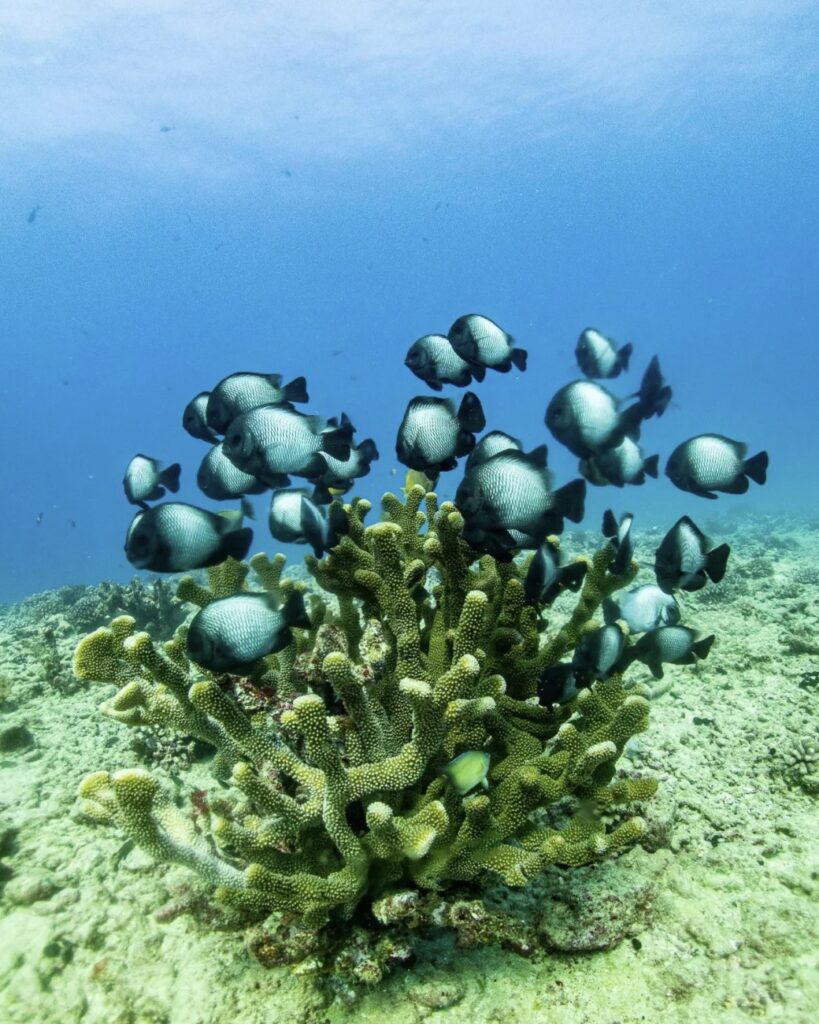
Jupiter, Florida, United States
Located on Florida’s Treasure Coast, Jupiter is known for drift diving along deep ledges in the nutrient-rich Gulf Stream. Access requires boat charters and ideal conditions. The reefs are part of the Southeast Florida Coral Reef Ecosystem Conservation Area, and many dive shops partner with conservation groups for turtle monitoring and reef cleanups.
- Scuba prerequisites: Advanced Open Water strongly recommended due to depth (~60–100 ft), drift current, and frequent encounters with large pelagics.
- When to go: June to September for peak goliath grouper aggregation; March to May for lemon sharks.
- Marine life to see: Goliath grouper, lemon sharks, loggerhead and green sea turtles, nurse sharks, and eagle rays.
- Best sites: Area 51 (Advanced), Captain Mike’s Reef (Advanced)
Resurrection Bay, Seward, Alaska, United States
This glacial fjord system in Seward, southern Alaska offers cold-water diving among kelp forests, steep walls, and wrecks. Accessible by boat, the area is part of the Alaska Maritime National Wildlife Refuge. Diving here supports cold-water conservation tourism and local eco-guides committed to minimal-impact practices.
- Scuba prerequisites: Dry suit certification and cold-water experience highly recommended.
- When to go: June to August for the warmest water (around 45–55°F) and best visibility.
- Marine life to see: Giant Pacific octopus, wolf eels, plumose anemones, sculpin, and nudibranchs.
- Best sites: Eldorado Narrows (Advanced Dry Suit), Caines Head Wrecks (Advanced Dry Suit)
Socorro Islands, Revillagigedo Archipelago, Mexico
These islands are found about 250 miles off the southern tip of Baja California, Socorro Islands is a liveaboard-only scuba diving destination. Part of the Revillagigedo Archipelago, a UNESCO World Heritage Site and marine reserve with some of the strongest protections in the Americas.
- Scuba prerequisites: Advanced Open Water with 50+ dives strongly recommended due to remoteness, surge, and depth.
- When to go: November to May for peak big animal season.
- Marine life to see: Giant oceanic manta rays, humpback whales, whale sharks, hammerheads, silky sharks, and dolphins.
- Best sites: Roca Partida (Advanced), Cabo Pearce (Advanced), The Boiler (Advanced)
Flower Garden Banks, Gulf of Mexico, United States
Located ~100 miles offshore in the Gulf of Mexico accessed by liveaboard boat diving only. A designated Flower Garden Banks National Marine Sanctuary, this remote and pristine reef system is protected from coastal pollution. Anchoring is prohibited; strict visitor limits are enforced.
- Scuba prerequisites: Advanced Open Water is recommended due to depth, remote location, and surge. Recent dive experience required.
- When to go: July to September for the best sea conditions and coral spawning events.
- Marine life to see: Whale sharks, hammerheads, manta rays, coral spawning, giant sponges, and schooling jacks.
- Best sites: West Flower Garden Bank (Advanced), East Bank (Advanced), Stetson Bank (Advanced)
Chinchorro Banks (Banco Chinchorro), Mahahual, Quintana Roo, Mexico
This remote atoll off southern Mexico is the largest coral atoll in the Northern Hemisphere. Part of the Banco Chinchorro Biosphere Reserve, access is highly restricted, with a limited number of divers allowed per day to preserve its pristine condition. It’s only accessible by boat and requires coordination with licensed operators.
- Scuba prerequisites: Advanced Open Water or minimum 20 dives due to remote location and strong currents.
- When to go: May to September for calm weather; avoid hurricane season.
- Marine life to see: American crocodiles (in shallow mangroves), Caribbean reef sharks, eagle rays, black groupers, and healthy coral gardens.
- Best sites: Punta Isabel (Advanced), Wreck Alley (Advanced; multiple 17th–20th century wrecks)
Map of Scuba Diving Destinations You Can Feel Good About
Diving Conservation Spotlight: Reef Environmental Education Foundation (REEF)
At TripOutside, we believe that outdoor adventure and conservation go hand in hand—which is why we’re proud to feature REEF, an international marine conservation organization implementing hands-on programs to involve local communities in conservation-focused activities.
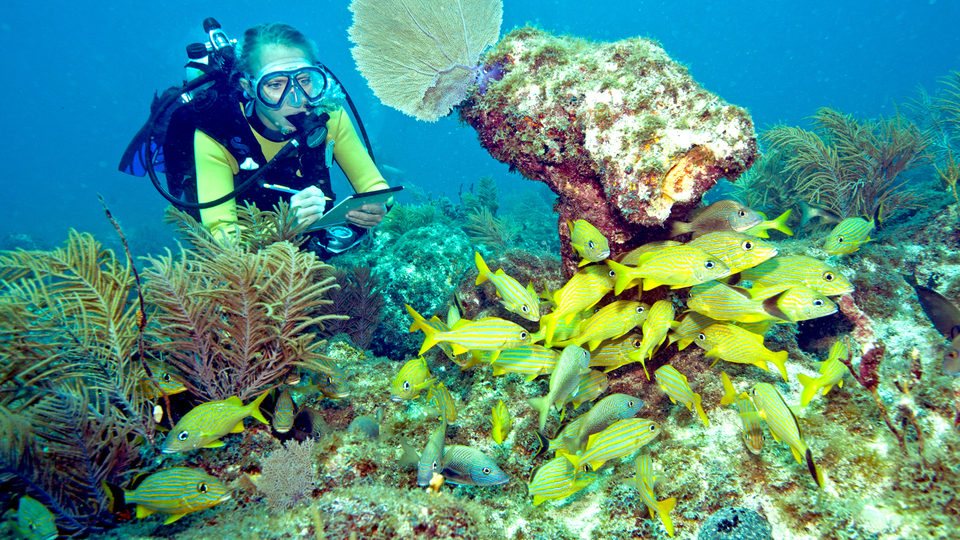
Who They Are & Where They Work
The Reef Environmental Education Foundation (REEF) is a nonprofit marine conservation organization founded in 1990 by divers and marine enthusiasts concerned about the health of the ocean. Based in Key Largo, Florida, with staff across several U.S. states, REEF’s mission is to protect biodiversity and ocean life by actively engaging and inspiring the public through citizen science, education, and partnerships with the scientific community.
REEF operates globally, with programs in coastal areas of North and Central America, the Caribbean, Eastern Atlantic and Mediterranean, Hawaii, the South and Indo-West Pacific, Indian Ocean, and Red Sea. REEF comprises a dedicated team of scientists, educators, and volunteers passionate about marine conservation. Their work is supported by a network of over 17,000 volunteer divers and snorkelers who contribute to various programs and initiatives.
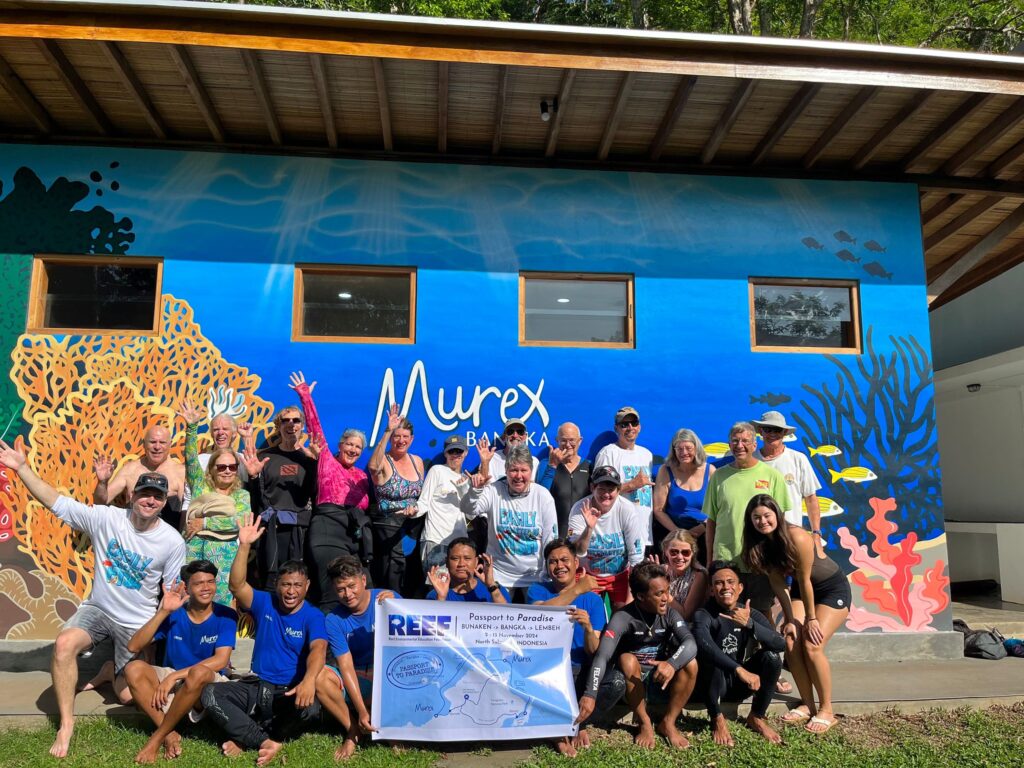
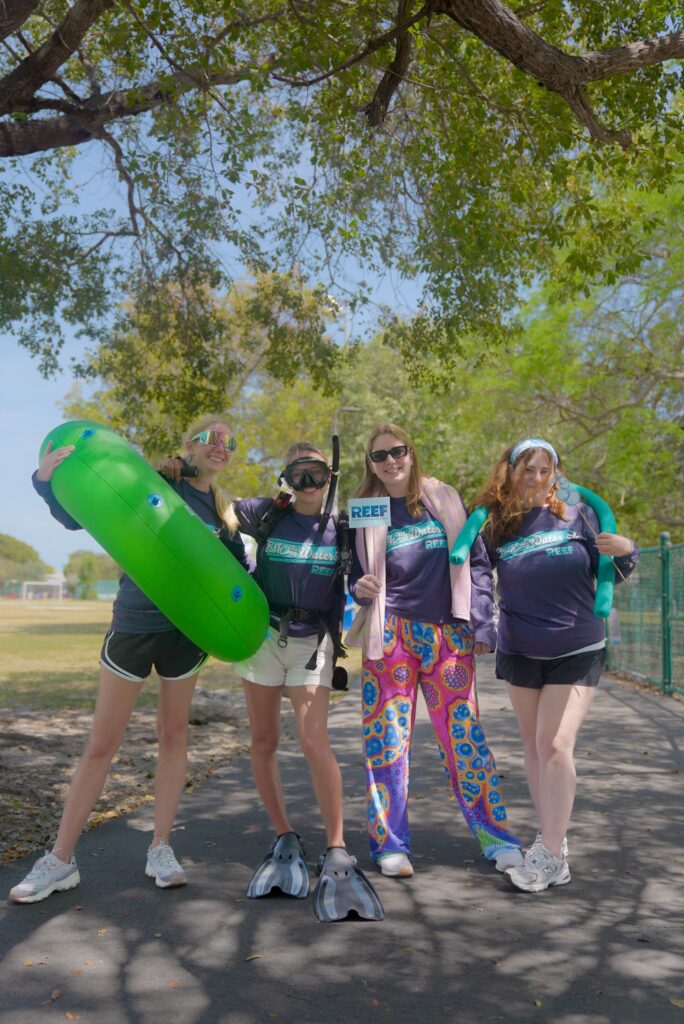
Reef’s Four Core Programs
Volunteer Fish Survey Project
This flagship citizen science program enables divers and snorkelers to collect and report data on marine fish populations, as well as selected invertebrate and algae species. Utilizing the Roving Diver Technique, participants conduct visual surveys and submit their findings to REEF’s publicly accessible database, which has amassed over 300,000 surveys from nearly 18,000 sites worldwide.
Grouper Moon Project
In collaboration with the Cayman Islands Department of Environment, this project focuses on the study and protection of Nassau grouper spawning aggregations. Research and conservation efforts aim to ensure the sustainability of this iconic Caribbean species.
Invasive Species Program
This initiative addresses the issue of non-native marine species, particularly the invasive lionfish in the western Atlantic. Through organized removal events, public education, and research, REEF works to mitigate the impact of invasive species on native marine ecosystems.
Ocean Explorers Education Program
REEF offers a range of educational opportunities for students, educators, and the public, including virtual field trips, classroom resources, and hands-on learning experiences. These programs aim to foster a deeper understanding and appreciation of marine environments.
How You Can Support
- Become a Member: Joining REEF is free and open to anyone interested in marine conservation. Members receive newsletters, access to educational resources, and opportunities to participate in programs.
- Participate in Surveys: Divers and snorkelers can contribute to the Volunteer Fish Survey Project by conducting surveys during their dives and submitting data to REEF’s database.
- Attend Events: REEF hosts various events, including workshops, seminars, and the annual REEF Fest, providing opportunities for education and community engagement.
- Donate: Financial contributions support REEF’s ongoing conservation and education efforts.
- Shop: Purchasing merchandise from the REEF store helps fund their programs.
Scuba Diving / Travel Insurance
Scuba diving opens up an incredible world beneath the surface, but like any adventure activity, it carries some unique risks—especially when you’re traveling. While dive emergencies are thankfully rare, they do happen, and many standard travel insurance plans won’t cover them. That’s why it’s so important to consider specialized dive insurance before your trip. We recommend checking out DAN (Divers Alert Network) – they’ve been the trusted leader in dive safety and trip insurance for decades, with plans built specifically for divers. Their coverage can include everything from emergency medical evacuation and treatment for dive-related incidents to trip cancellations, gear coverage, and more. DAN also plays a critical role in supporting dive safety research and education around the world. With the right insurance, you can dive with peace of mind, knowing you’re protected if something goes sideways. Explore their coverage options to find the best fit for your next underwater adventure!
Final Thoughts: Let’s Get Out to These Scuba Diving Destinations & Dive!
Writing this guide has only made me more stoked to explore these dive destinations firsthand. From remote atolls to reef restoration hotspots, there’s so much to see—and even more to protect. I’ve already got a few of these spots on my personal bucket list, and I’d love to hear which ones you’re dreaming about too. If you want to swap dive stories, ask questions, or just geek out about marine life, hop into our Discord community. It’s full of ocean lovers like you, and we’re always down to chat about where to go next!

